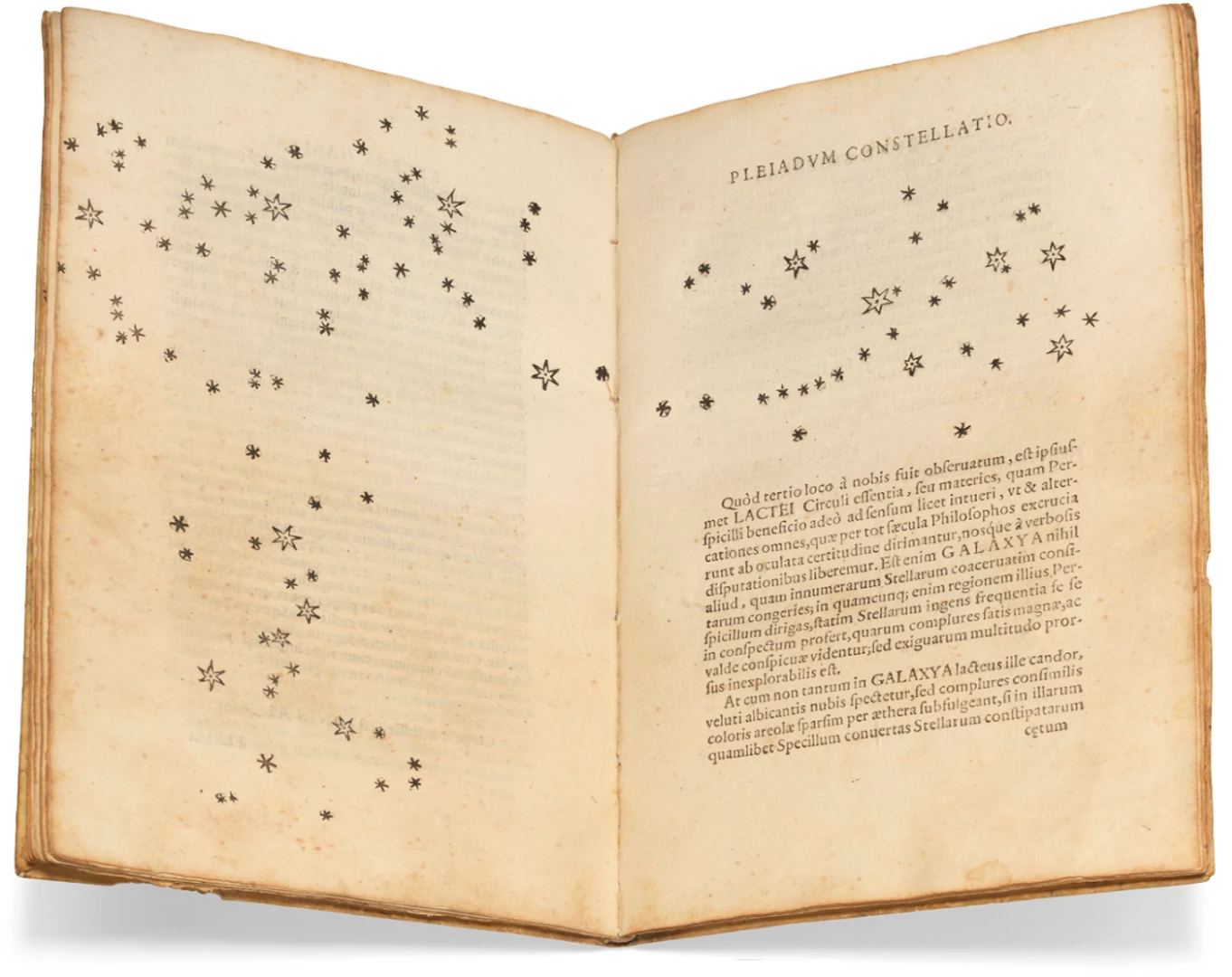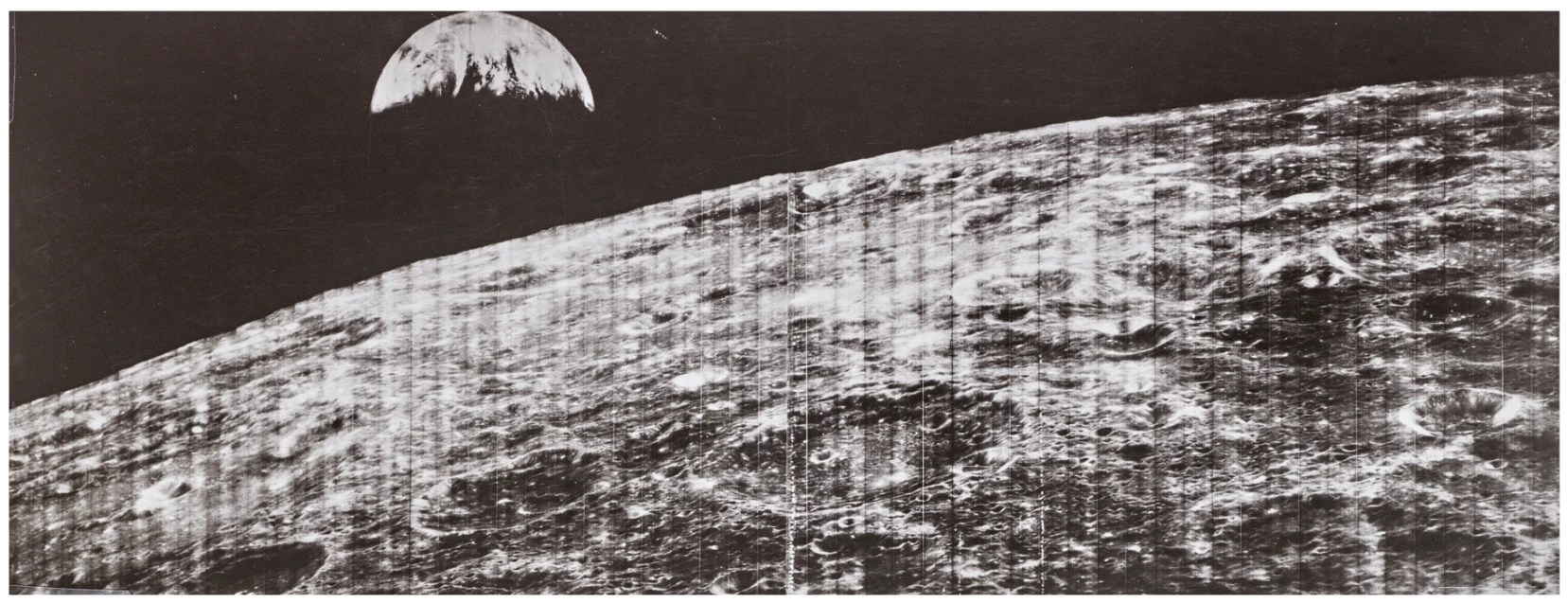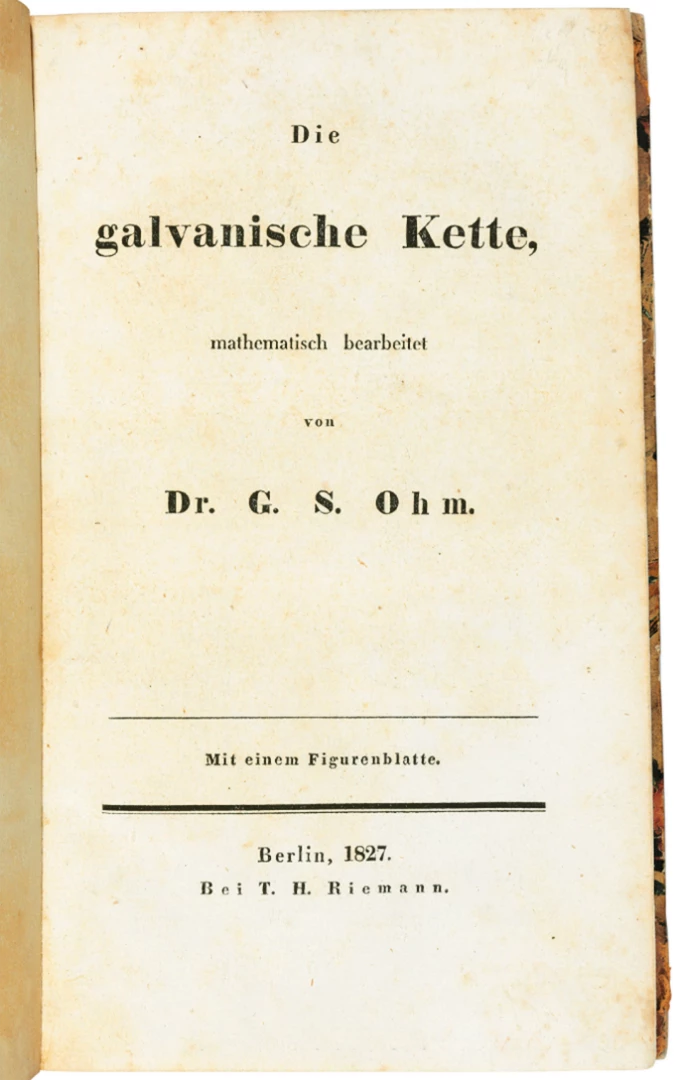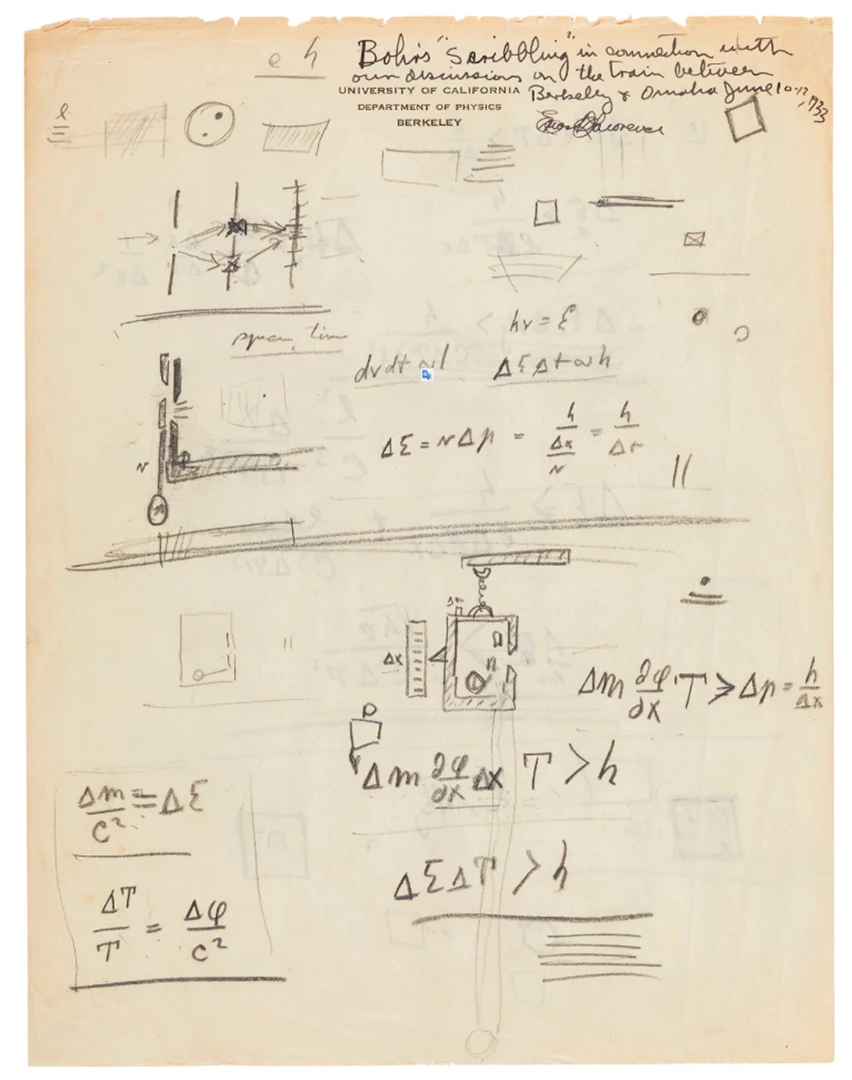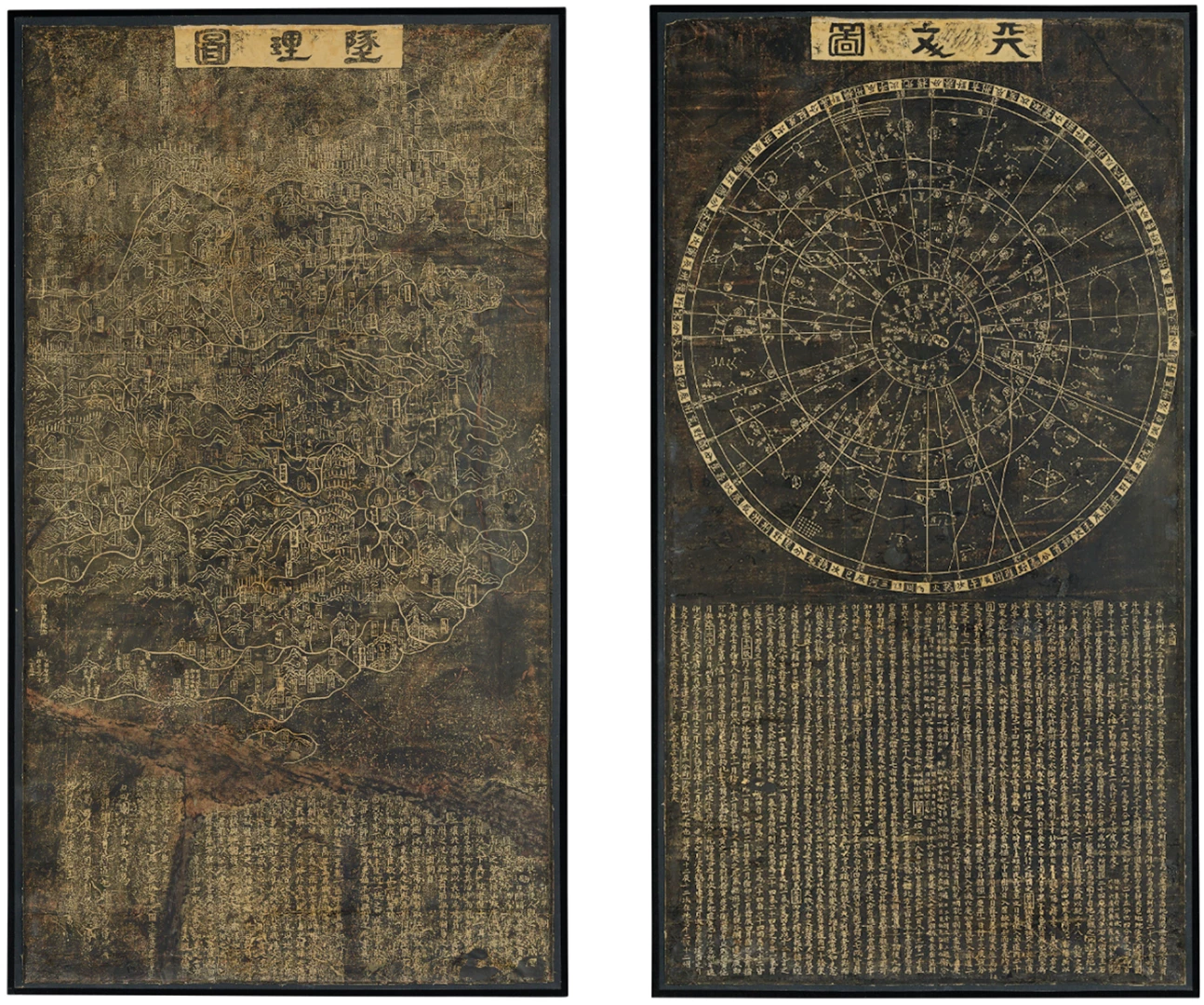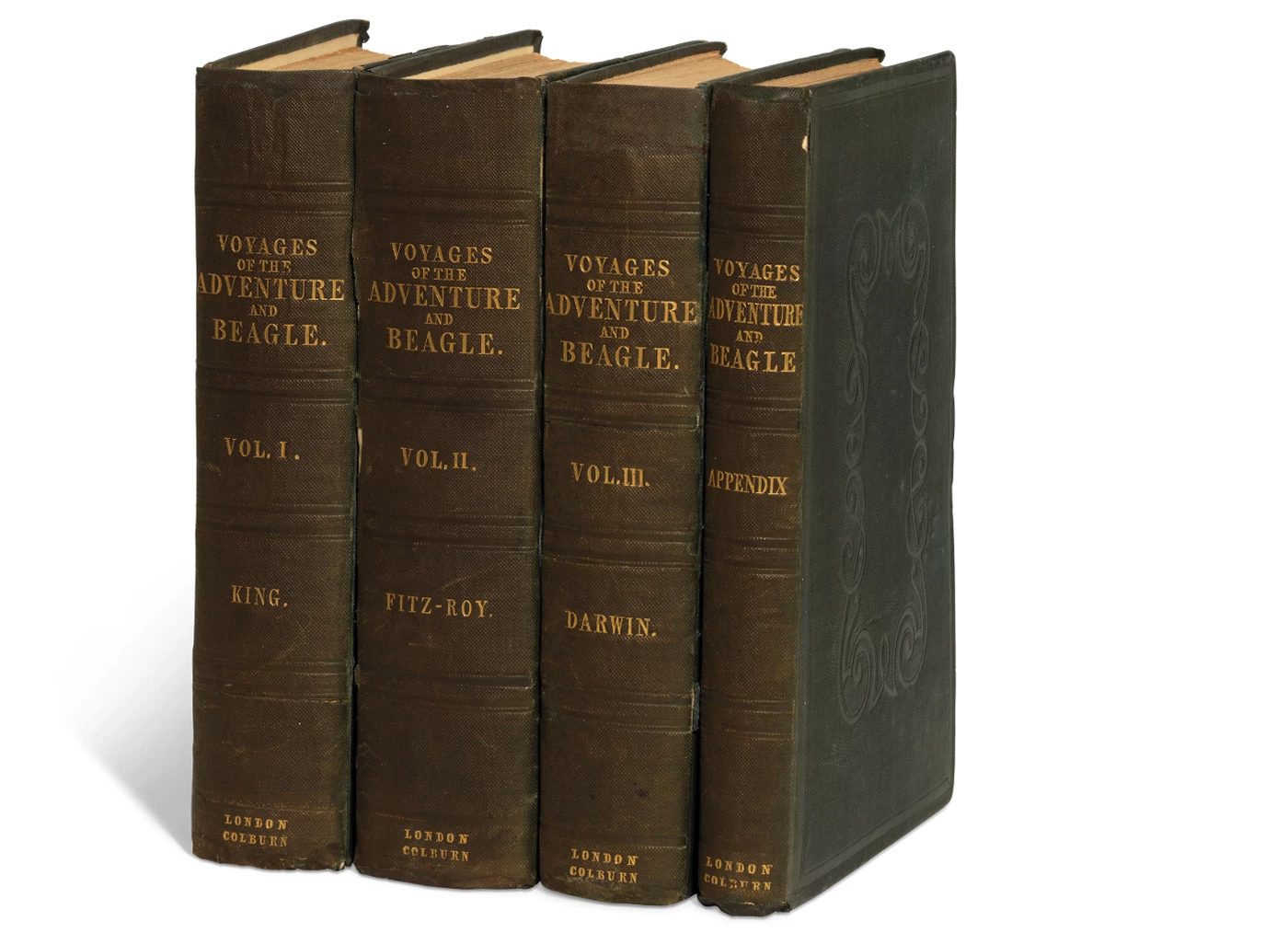The month of July, 2019 will be a bumper one for the number of landmark scientific artifacts heading for auction. Three Christie's auctions and a Sotheby's auction have such a stellar array of scientific documents, manuscripts, tablets, seals and artifacts that we thought it worthwhile documenting them, even though in some cases, they are estimated to sell for quite affordable amounts.
The original, first-generation NASA videotape recordings of the Apollo 11 Lunar EVA
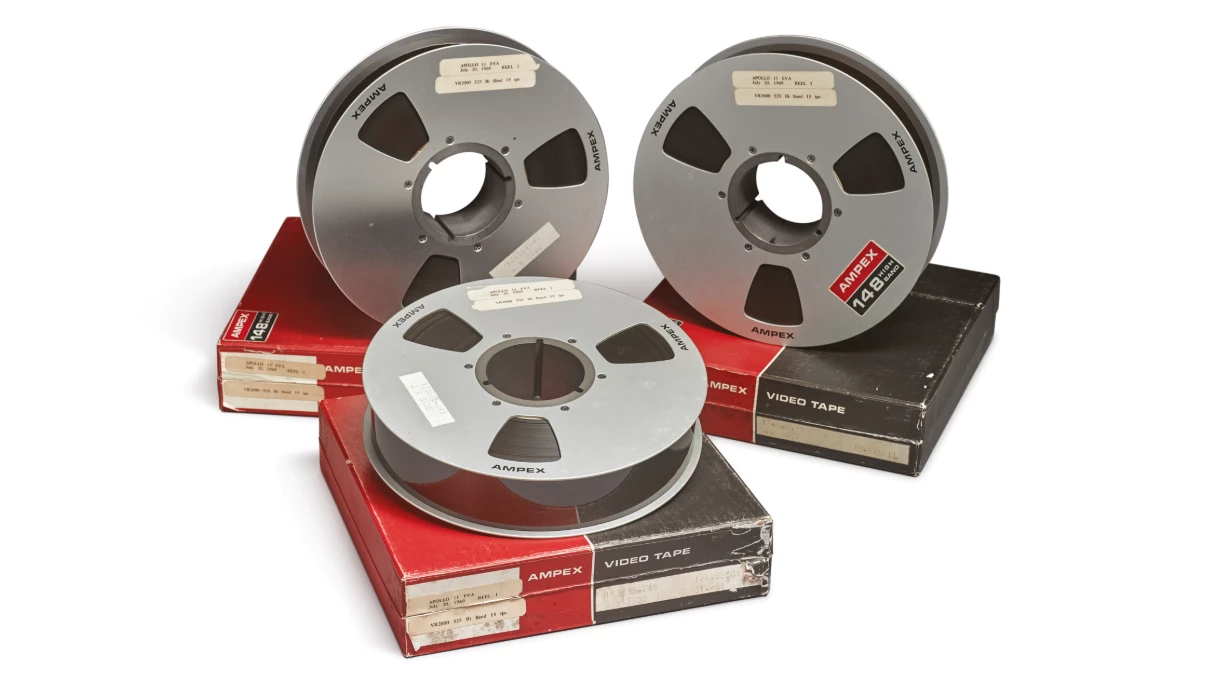
Auction Description | Estimate: US$1,000,000 to $2,000,000 | Auction Date: July 21, 2019
Three original unrestored, unenhanced and unremastered NASA videotape recordings of the Apollo 11 lunar landing marked EVA (Extravehicular Activity). These tapes were purchased by Gary George, along with another 1,147 tapes at a government surplus auction in 1973 for $217.77 and he certainly got a lot more than he thought with that purchase.
The tapes are believed to have been viewed just three times since they were originally recorded on the Moon.

Miraculously, the tapes are in faultless condition, and have been digitized directly to 10-bit uncompressed files, and are being sold with an accompanying a one-terabyte hard drive.
The earliest known map of China and a map of the stars c.1495-c.1650

Auction Description | Estimate: $506,800 to $760,200 | Auction Date: July 10, 2019
This pair of maps backed on 19th-century canvas, and each measuring 1,830 x 1,000 mm, comprise the oldest extant Chinese-printed terrestrial map of China, and a companion star map.
The Dili Tu (geographic map of China) and the Tianwen tu (a map of the stars] were originally made in about 1190 by the polymath Huang Shang for presentation to the Song Emperor in 1194. Huang Shang's maps no longer survive, however, in 1247, copies were engraved on stone stelae and rubbings were taken from the stones. The paper of this lot has been tested to show a very early date range of c.1495-c.1650, with the earlier date being much more likely. All four of the stone engravings of Huang Shang's work are still extant and preserved.
Rubbings taken from the stones are now highly regulated by the Chinese government, in order to preserve the stones from further damage. Most extant rubbings are held in institutions within China. The most recent rubbings of the Tianwen tu were the 10 authorized by the Chinese government in the 1990s; nine went to Chinese museums and institutions, and one is now in the History of Chinese Science and Culture Foundation in London. The foundation's website notes that its copy "is believed to be the only original rubbing of it in the West," highlighting the rarity of this second example.
De revolutionibus orbium coelestium by Nicolaus Copernicus (1543)
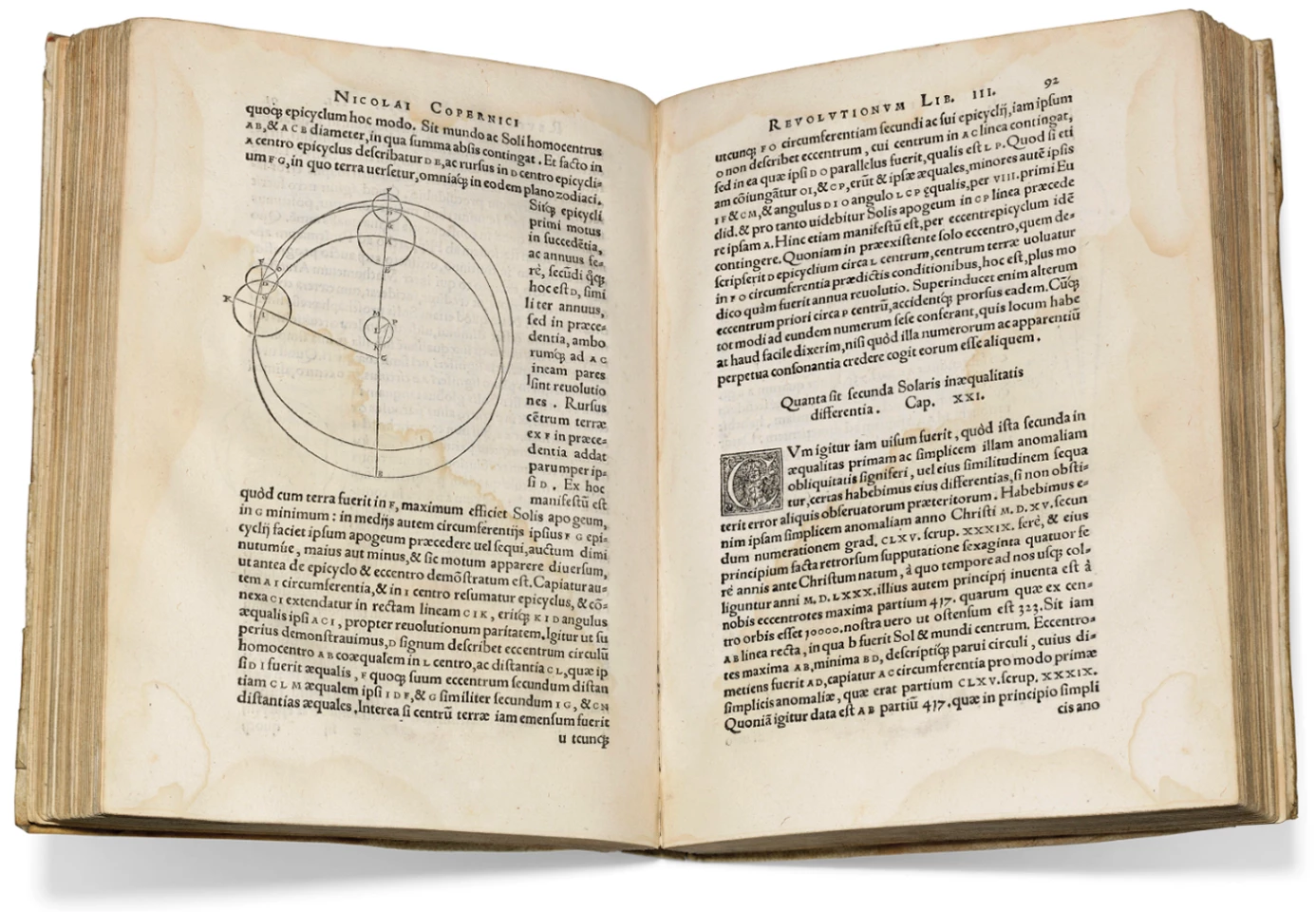
Auction Description | Estimate: $633,000 to $886,200 | Auction Date: July 10, 2019
De revolutionibus orbium coelestium (On the revolutions of the heavenly spheres), by Nicolaus Copernicus was published less than 500 years ago, and for the first time presented compelling evidence that the Earth was not the center of the universe with Copenicus' heliocentric theory. This book was published in 1543, though its core text was written at least 30 years prior, and Copernicus resisted publication for many decades due to its heretical implications. He was finally handed one of the first printed copies on his death bed – a copy from the same print run as the copy to be auctioned.
First editions of this book have three times fetched more than a million dollars, being $1,295,767 (£825,250 | Sotheby's | November 30, 2011), $1,224,608 (£666,400 | Sotheby's | June 10, 2004) and $1,069,805 (£662,500 | Christie's | November 20, 2013).
Narrative of the Surveying Voyages of His Majesty's Ships Adventure and Beagle by Charles Darwin and Robert Fitzroy (1839)

Auction Description | Estimate: $75,960 to $113,940 | Auction Date: July 10, 2019
This valuable historical "First Edition" is a four-book presentation set on the voyages of the English ships H.M.S Beagle and H.M.S Adventure. The third book in the set is a First Edition of Charles Darwin's first published book, and is inscribed by the Commander of the Beagle.
Discours de la méthode pour bien conduire sa raison, et chercher la vérité dans les sciences by René Descartes (1637)

Auction Description | Estimate: $101,280 to $151,920 | Auction Date: July 10, 2019
René Descartes (1596 – 1650) was a French philosopher, mathematician, and scientist. One of the most notable intellectual figures of the Dutch Golden Age, Descartes is also widely regarded as one of the founders of modern philosophy.
The auction lot is a first edition of the author's first published and most famous work, and is widely regarded the foundation of all modern scientific and philosophic thought.
In this book, Descartes propounds his belief in the truth of thought ("cogito, ergo sum" – "I think, therefore I am"), advances the necessity of mathematical proof, discusses Harvey's discovery of the circulation of blood, and includes appendices on geometry, optics, and meteors. From these central propositions in logic, metaphysics and physics came the subsequent enquiries of Locke, Leibniz and Newton; from them stem all modern scientific and philosophic thought.
Previous sales of this book include $171,000 (Christie's | October 9, 2001), $170,750 (Sotheby's | November 2001 | no link), $171,288 (£92,960 | Sotheby's | November 4, 2004) and the highest price achieved at auction was $297,789 (£162,050 | Christies | June 2, 2004).
The first image of the Earth from the moon

Auction Description | Estimate: $3,000 to $5,000 | Auction Date: July 21, 2019
This silver gelatin print, measuring 11 5/8 by 4 1/4 in, was the first ever image taken of Planet Earth from the Moon. It was taken by Lunar Orbiter I from 730 miles above the far side of the Moon, on August 23, 1966.
The Schøyen Collection of Medieval Seal Matrices
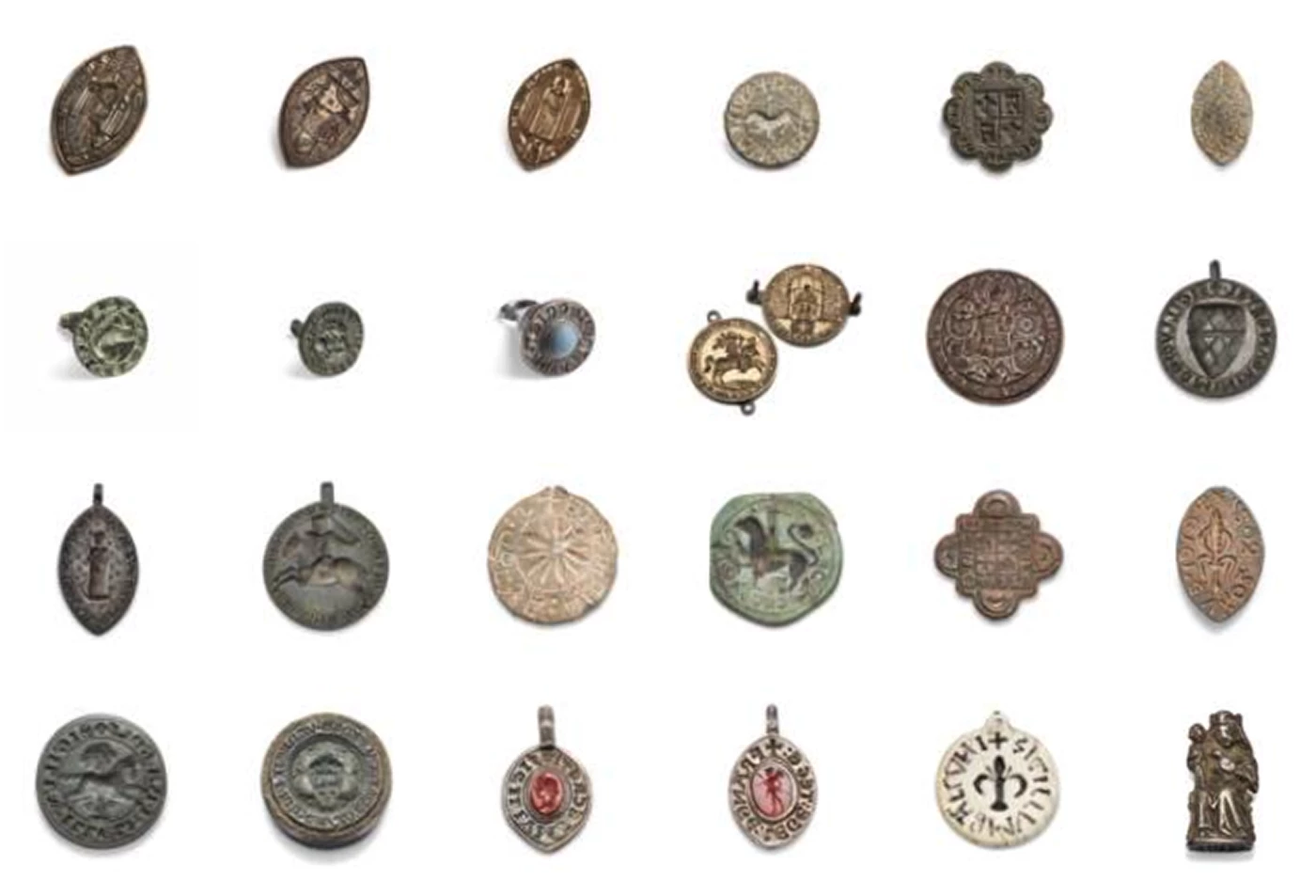
Auction Description | Estimate: $126,600 to $189,900 | Auction Date: July 10, 2019
Seals were once used to authenticate a document, making their impression on wax, clay, or paper. The Schøyen Collection of Medieval Seal Matrices is one of the largest collections in the world, and is believed to be the largest collection of private seal matrices. It comprises 402 individual matrices ranging in date from the 12th to the end of the 16th century, and in various materials including lead, silver, bronze and classical gemstones.
Grooten Atlas (Atlas Major) by Willem and Jan Blaeu (1664)
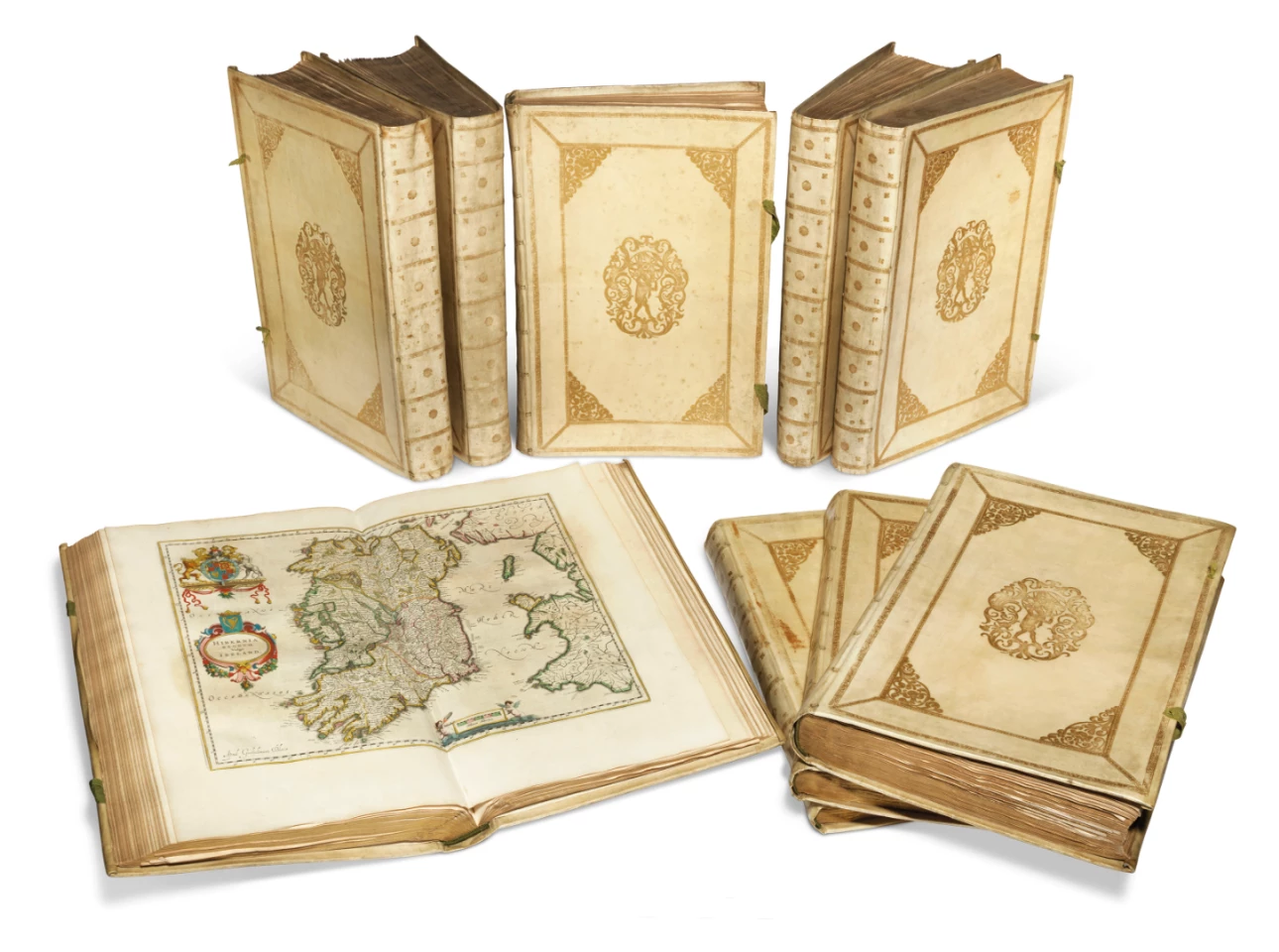
Auction Description | Estimate: $569,700 to $822,900 | Auction Date: July 10, 2019
This book is one of the many remarkable achievements of a father and son who contributed so much to our understanding of the world. Both Dutch cartographers, atlas and globe makers and publishers, Johannes (aka Jan, Joan) Blaeu (1596 – 1673) was the son of cartographer Willem Blaeu. The Atlas Major was published between 1662 and 1672, in Latin (11 volumes), French (12 volumes), Dutch (9 volumes), German (10 volumes) and Spanish (10 volumes), containing 594 maps and around 3,000 pages of text. It was the largest and most expensive book published in the 17th century and is often cited as "the most famous atlas in the history of printed maps" and "the most magnificent work of its kind ever produced."
The record price fetched by this set of books is $883,944 (£581,000) at a Sotheby's (London) auction in November, 2015.
Philosophiae naturalis principia mathematica by Sir Isaac Newton (1687)

Auction Description | Estimate: $316,500 to $443,100 | Auction Date: July 9, 2019
This first edition of Philosophiae naturalis principia mathematica by Sir Isaac Newton (1687) is one of the most important works in the history of science. It gave us Newton's laws of motion, forming the foundation of classical mechanics; Newton's law of universal gravitation; and a derivation of Kepler's laws of planetary motion (which Kepler first obtained empirically).
The French mathematical physicist Alexis Clairaut assessed it in 1747: "The famous book of Mathematical Principles of Natural Philosophy marked the epoch of a great revolution in physics. The method followed by its illustrious author Sir Newton ... spread the light of mathematics on a science which up to then had remained in the darkness of conjectures and hypotheses."
Not surprisingly, first edition copies such as this are rare and very valuable. The record price fetched by a first edition were both obtained by Christies in New York: $3,719,500 on December 14, 2016 and $2,517,000 on December 6, 2013.
Sidereus Nuncius by Galileo Galilei (1610)

Auction Description | Estimate: $379,800 to $633,000 | Auction Date: July 9, 2019
Sidereus Nuncius is one of the landmark scientific publications in history. Written by Italian polymath Galileo Galilei (1564 - 1642), the book introduced the world to his astronomical discoveries made using his home-made telescope. Even the word "telescope" was not even coined until the year after this book was published – Galileo refers to the device in this book as a "perspicillum."
Galileo did not invent the telescope, but when he heard about the device being built in Holland in 1609, he set about making his own. Within a few months, he had improved upon his first X9 magnification to a X32 magnification, pointed it towards the heavens and then published his observations in this book in 1610. Those observations included the first details of Jupiter's four moons and his revelations about galaxies such as the Milky Way consisting of numerous stars. The drawings he made of the craters of the Moon were published in this book for the first time and, building upon the previously published work of Nicolaus Copernicus, helped to change mankind's understanding of the universe from a geocentric (everything revolves around the Earth) model to a heliocentric (centered on the Sun) model. Recent evidence has come to light that English polymath Thomas Harriot examined and recorded the Moon through a telescope prior to the brilliant Italian, though it was this publication that became the foundation work of modern astronomy.
The record price for this book is $662,500 which was achieved at a Christie's (New York) auction in December, 2010.
Die Grundlage der allgemeinen Relativitäts theorie by Albert Einstein (1916)
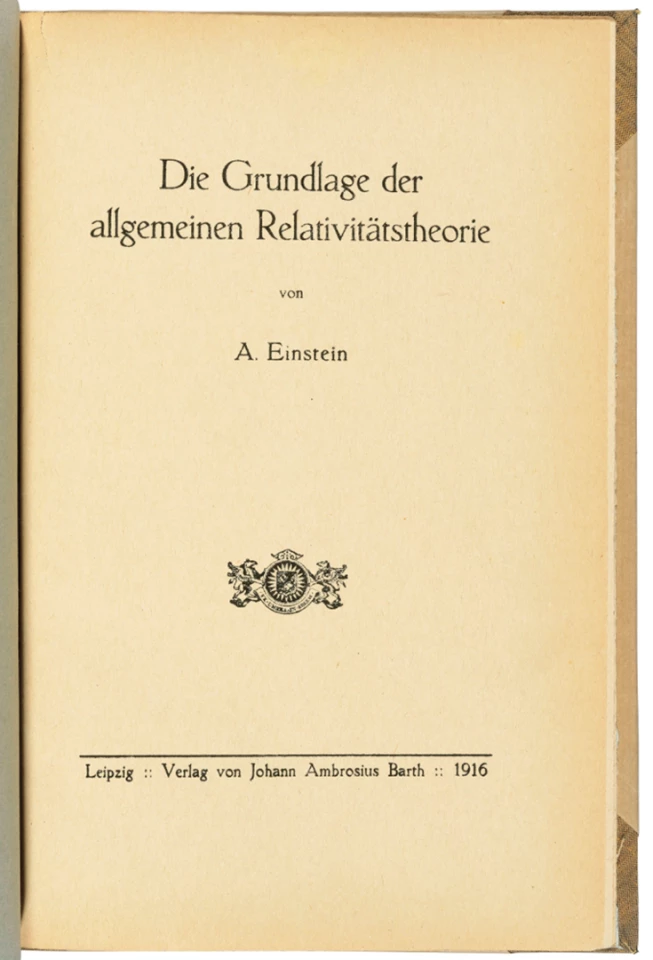
Auction Description | Estimate: $3,165 to $4,431 | Auction Date: July 9, 2019
This publication is the first separate printing of Einstein's fundamental theory of relativity, and is an offprint from Annalen der Physik, 4th series, 49 (1916) in which his landmark paper was first published. It differs slightly from the journal issue with textual revisions, the addition of a table of contents and an introduction by Einstein.
Mesopotamian Proto-Cuneiform Clay Tablet c.3100-3000 B.C.
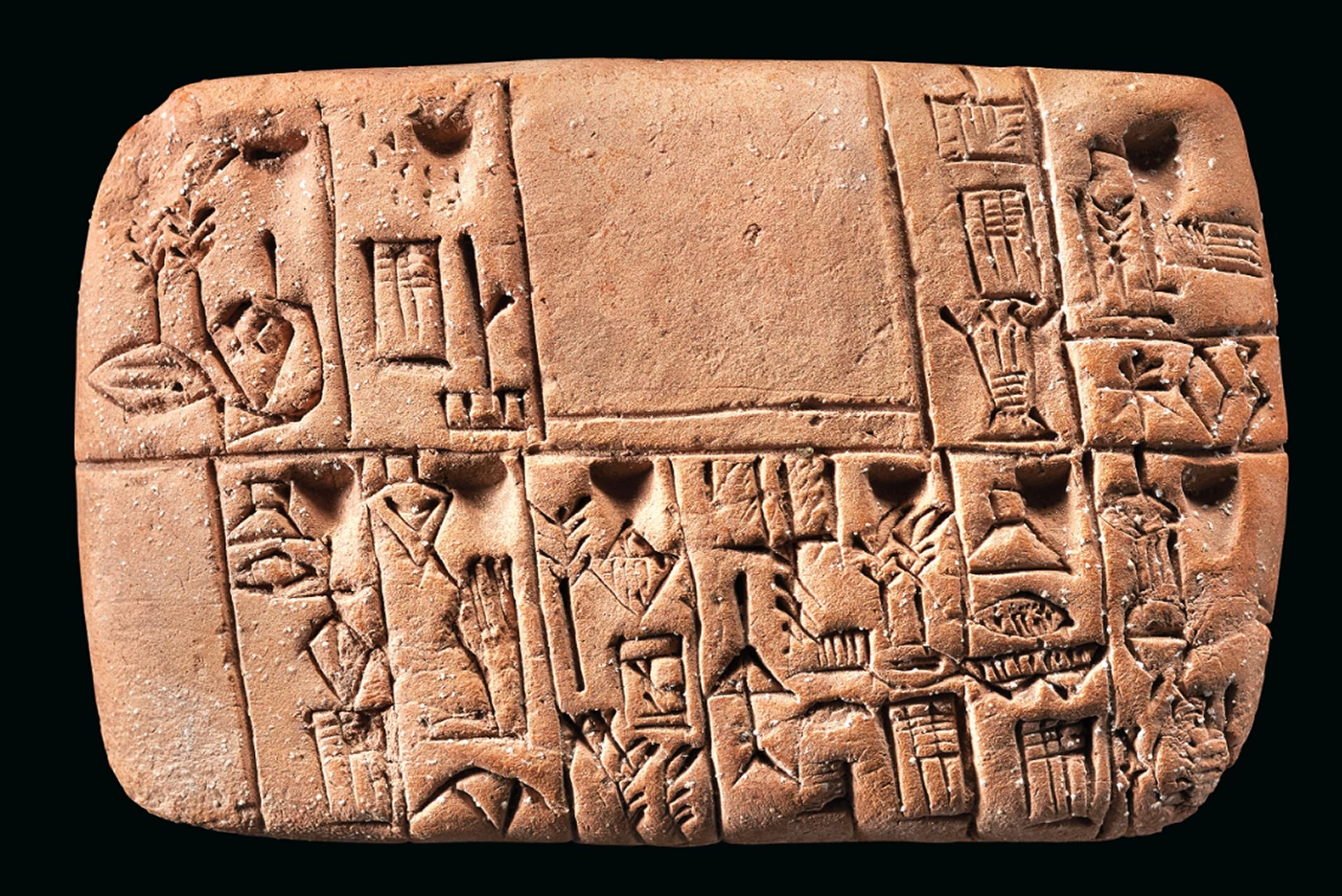
Auction Description | Estimate: $25,320 to $37,980 | Auction Date: July 10, 2019
Cuneiform is one of the earliest systems of writing. It was invented by the Sumerians, emerging in the late fourth millennium BCE in response to administrative needs of the local economies of southern Iraq. The pictographic script might be viewed as a complex form of shorthand, and remains almost impossible to decipher.
This tablet bears the proto-cuneiform pictographic script invented in Southern Mesopotamia more than 5,000 years ago – the earliest known recorded writing system by man. It was from this script that cuneiform evolved, with the pictographic signs becoming smaller and more abstract, composed in horizontal lines as opposed to vertical bands. This tablet is derived from a single archive of 77 pictographic tablets, all extant – 55 of these are now in Freie Universität in Berlin, four in the British Museum, three in the Metropolitan Museum, four in the Louvre, and six in the Schøyen Collection.
Only a small part of the Schøyen Collection is being auctioned in this sale, but another cuneiform tablet from the collection is being sold and can be found at Lot 402.
De architectura libri dece by Marcus Vitruvius Pollio (1st century BCE)
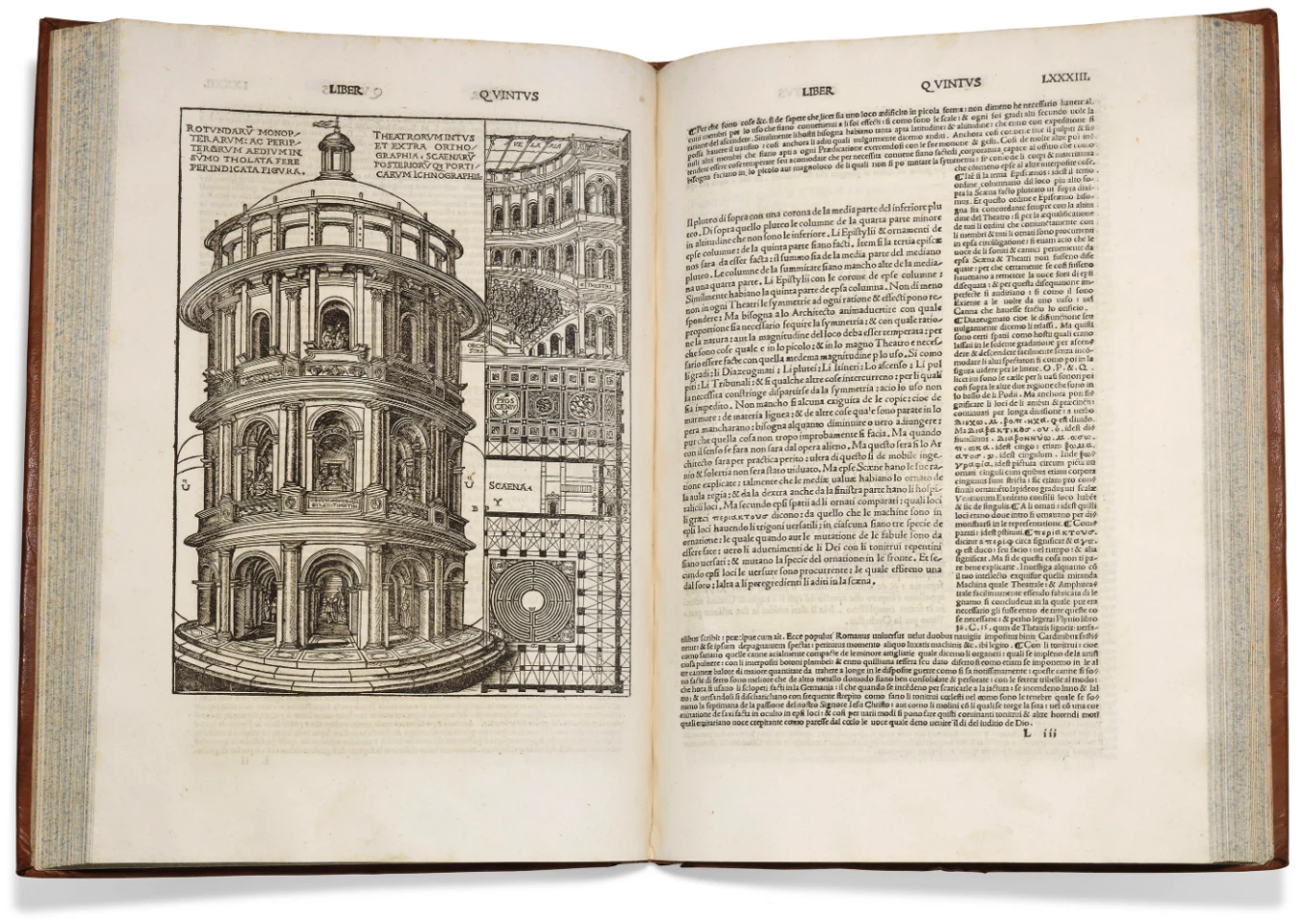
Auction Description | Estimate: $22,800 to $31,675 | Auction Date: July 10, 2019
De architectura (On architecture) is a treatise on architecture written by the Roman architect and military engineer Marcus Vitruvius Pollio and dedicated to his patron, the emperor Caesar Augustus, as a guide for building projects. It is the only treatise on architecture to survive from antiquity, it has been regarded since the Renaissance as the first book on architectural theory, as well as a major source on the canon of classical architecture.
The texts were translated by Cesare Cesariano (c.1478-1543) and this book was published in Como on July 15, 1521. The Como Vitruvius is regarded as one of the finest illustrated books of the Italian Renaissance, and this copy was originally part of the library of French humanist, Jacques Bongars, a counsellor to Henri IV of France.
The record for a copy of this book was set at $881,000 in a Christie's New York auction on December 3, 2007.
The seal of Wulfric c. first half 11th century
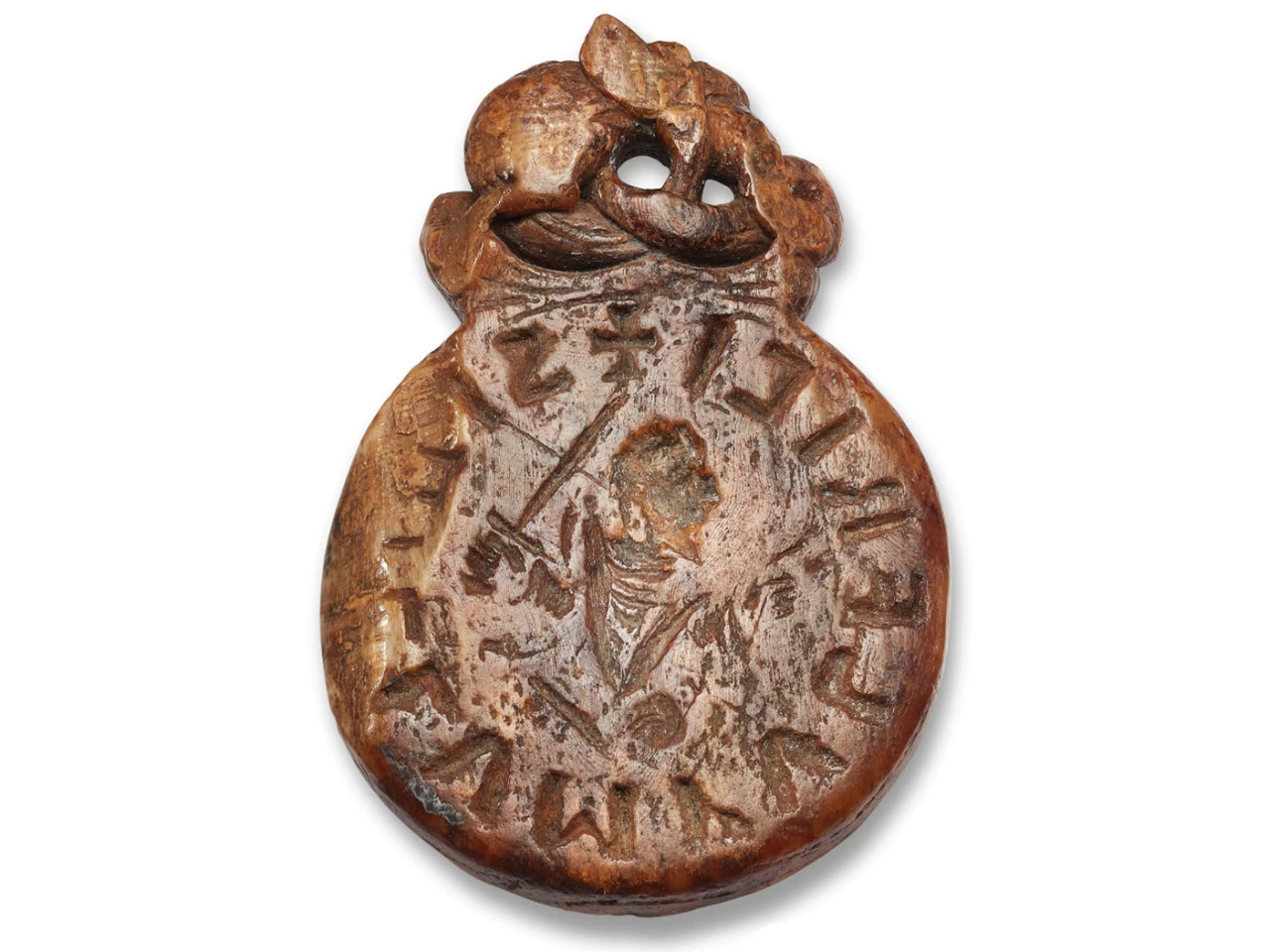
Auction Description | Estimate: $88,620 to $126,600 | Auction Date: July 10, 2019
This Anglo-Saxon walrus ivory seal matrix is one of only five surviving seal matrices from Anglo-Saxon England, and one of only three 11th-century ivory matrices. The other surviving 11th-century ivory seals from Anglo-Saxon England are the Godwin and Godgytha seal (British Museum) and the so-called Hubert seal, discovered in Lincoln in 1985 (Lincoln, City and County Musuem).
De Europische Insecten & Metamorphosis insectorum Surinamensium by Maria Sibylla Merian (1730)
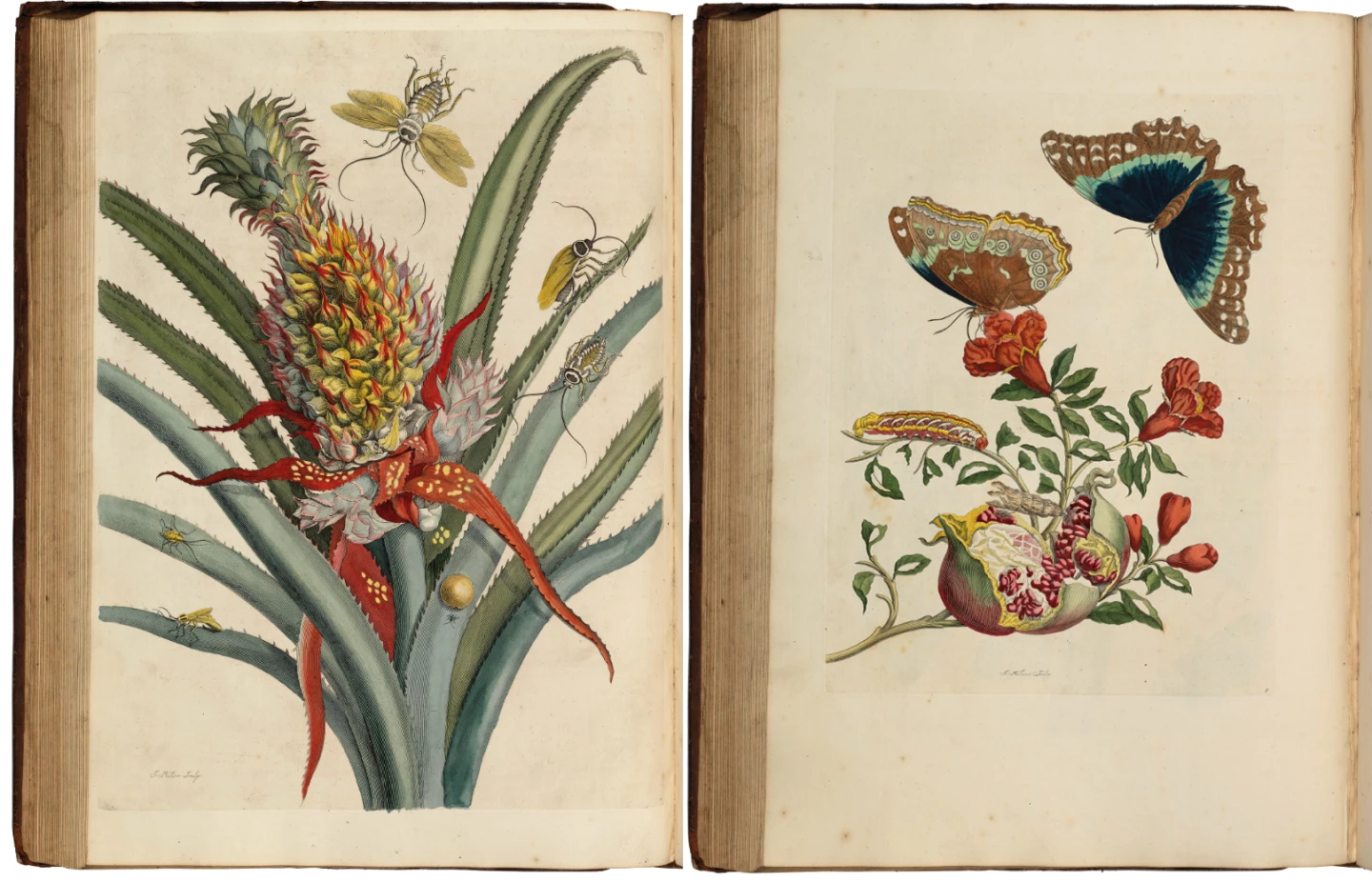
Auction Description | Estimate: $31,650 to $44,310 | Auction Date: July 10, 2019
Maria Sibylla Merian (1647 – 1717) was a German-born naturalist and scientific illustrator, who traveled at 52 years-of-age (in 1699) to the Dutch colony of Suriname in South America to observe and illustrate new species of insects, becoming arguably the first person in history to undertake an epic journey solely for scientific purposes. Her five-year expedition was cut short after two years when she contracted malaria, but the resultant publication of Metamorphosis Insectorum Surinamensium upon her return to Amsterdam became a foundation of the science of entomology. She is considered by David Attenborough to be among the most significant contributors to the field of entomology.
Now regarded as one of history's great female scientists, Merian overcame the many seemingly insurmountable gender-bias obstacles of the era to make an immense contribution to science. She worked in watercolors, for example, because oil paints were only available to men. A copy of her first book, Neues Blumenbuch, sold for $925,826 (£565,250) at a Christie's (London) auction in June, 2011 and is one of the top 50 most valuable scientific documents of all-time.
This volume, containing two of her best known works (Over de Voortteeling en Wonderbaerlyke Veranderingen der Surinaamsche Insecten was originally published as Metamorphosis Insectorum Surinamensium), was published 13 years after her death.
Versuche über Pflanzen-Hybriden by Johann Gregor Mendel (1865)
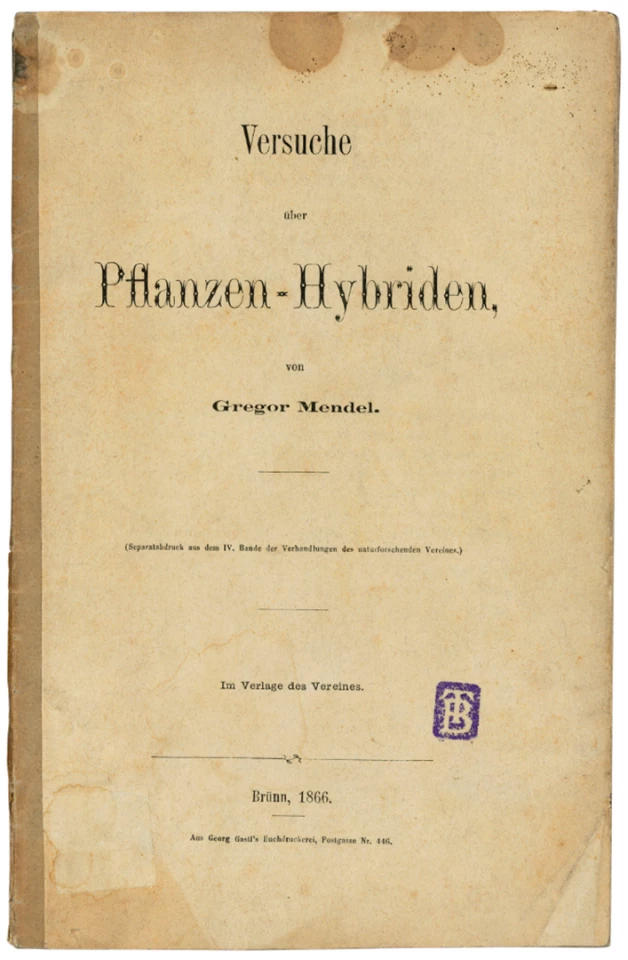
Auction Description | Estimate: $253,200 to $379,800 | Auction Date: July 9, 2019
Gregor Mendel (1822 – 1884) was a scientist, Augustinian friar and abbot of St. Thomas' Abbey in Brno. Mendel was born in a German-speaking family in the Silesian part of the Austrian Empire (today's Czech Republic) and gained posthumous recognition as the founder of the modern science of genetics. Though farmers had known for millennia that crossbreeding of animals and plants could favor certain desirable traits, Mendel's pea plant experiments conducted between 1856 and 1863 established many of the rules of heredity, now referred to as the laws of Mendelian inheritance.
This paper is one of only 14 known extant offprints, and one of only six known copies with contemporary manuscript corrections. The paper ''reports the results of ten years of experimental work on artificial plant hybridization, during which he followed a program designed to test his working hypothesis that hereditary matter is discrete and particulate. Mendel bred and cultivated nearly thirty thousand pea plants, performing careful statistical analyses of the distribution of seven pairs of mutually exclusive seed and plant characteristics – a manageable number that allowed him to observe all possible combinations of traits" (Grolier Medicine).
On the Origin of Species by Means of Natural Selection by Charles Darwin (1859)
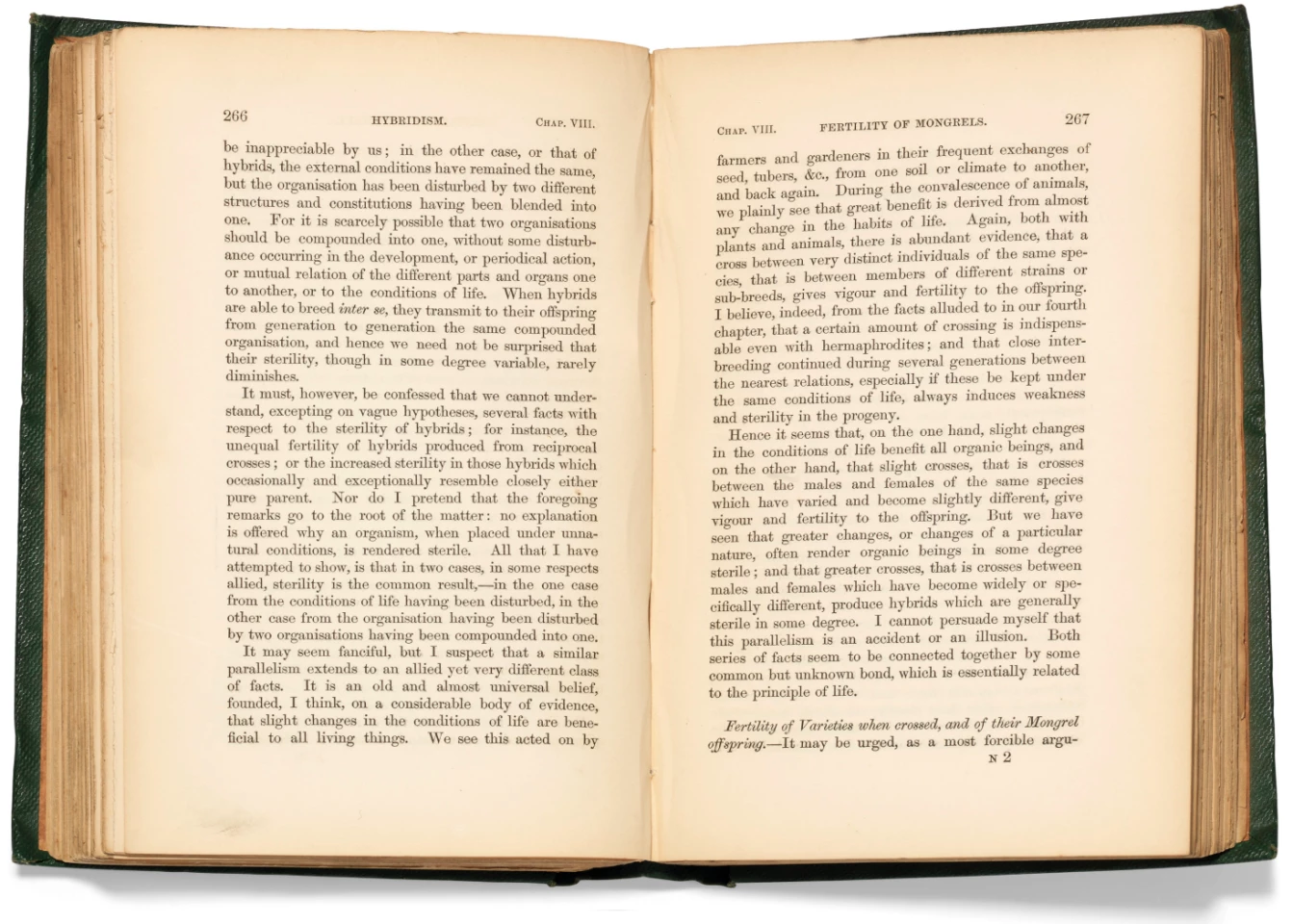
Auction Description | Estimate: $177,240 to $253,200 | Auction Date: July 9, 2019
Charles Darwin (1809 – 1882) was an English naturalist, geologist and biologist, best known for his contributions to the science of evolution. His proposition that all species of life have descended over time from common ancestors is now widely accepted, and considered a foundational concept in science. Darwin published his theory of evolution with compelling evidence in this 1859 book On the Origin of Species. By the 1870s, the scientific community and a majority of the educated public had accepted evolution as a fact. However, many favored competing explanations, and it was not until the emergence of the modern evolutionary synthesis from the 1930s to the 1950s that a broad consensus developed in which natural selection was the basic mechanism of evolution. Darwin's scientific discovery is the unifying theory of the life sciences, explaining the diversity of life.
The record for a first edition copy of this book was set on June 14, 2019 at US$500,075, though a copy of the third edition, which had Darwin's hand-written revisions in the margins, sold for $1,054,100 (£788,75) at a Christie's auction on December 13, 2017.
Tychonis Brahe, Dani De nova et nullius aevi memoria prius visa stella by Tycho Brahe (1573)
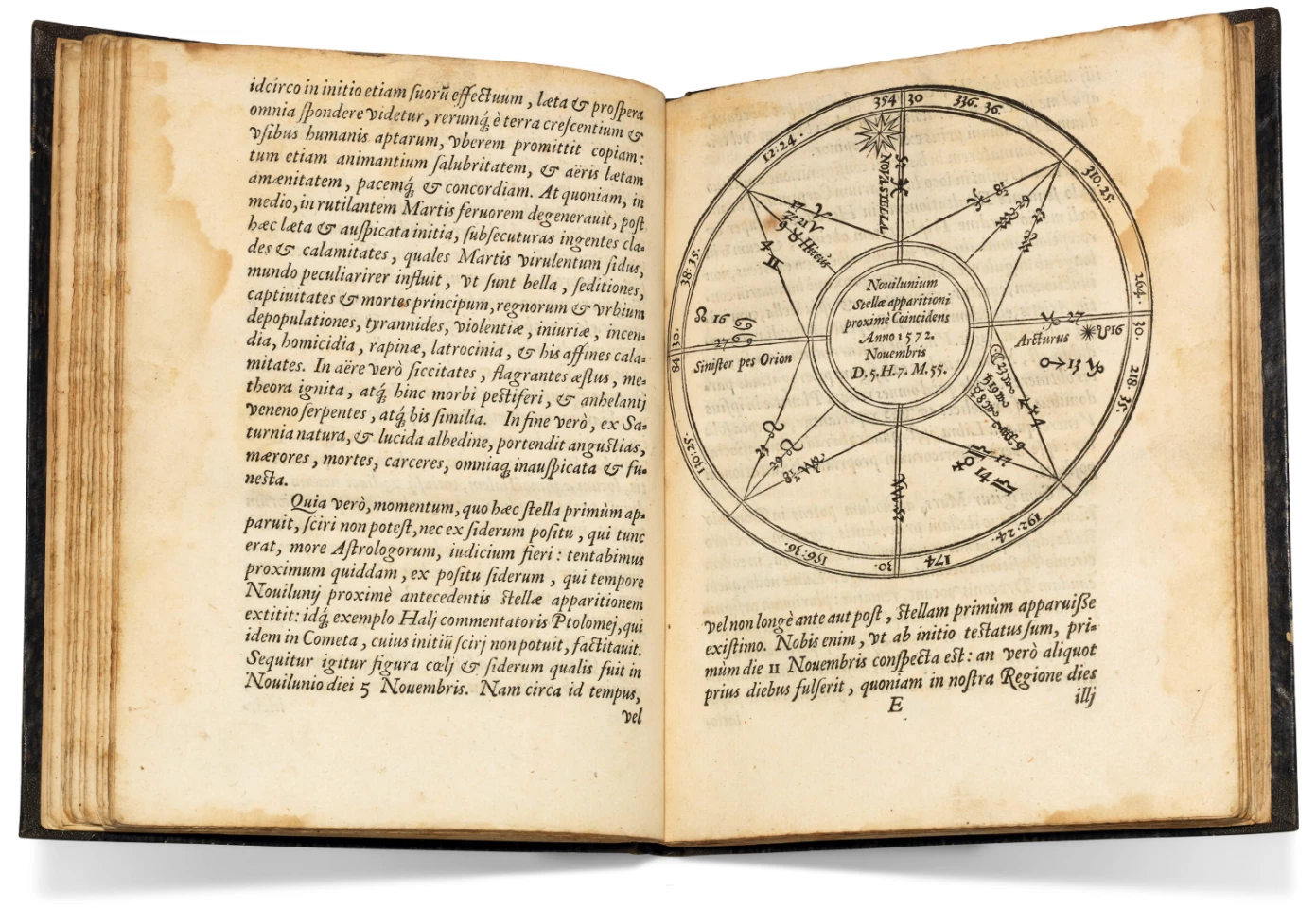
Auction Description | Estimate: $88,620 to $126,600 | Auction Date: July 9, 2019
Tycho Brahe (1546 – 1601) was a Danish nobleman, astronomer, and writer known for his accurate and comprehensive astronomical and planetary observations. He was born on the then Danish peninsula of Scania. Well known in his lifetime as an astronomer, astrologer and alchemist, he has been described as "the first competent mind in modern astronomy to feel ardently the passion for exact empirical facts." His observations were some five times more accurate than the best available observations at the time.
From the Auction Description, this is "first edition of one of the rarest and most important pamphlets in the history of science: Tycho Brahe's discovery of a new star, the emphatic first-ever use of the term 'nova' in relation to a star, and the incontrovertible refutation of the Aristotelian model of an unchanging celestial realm."
Harmonices mundi libri V by Johannes Kepler (1619)
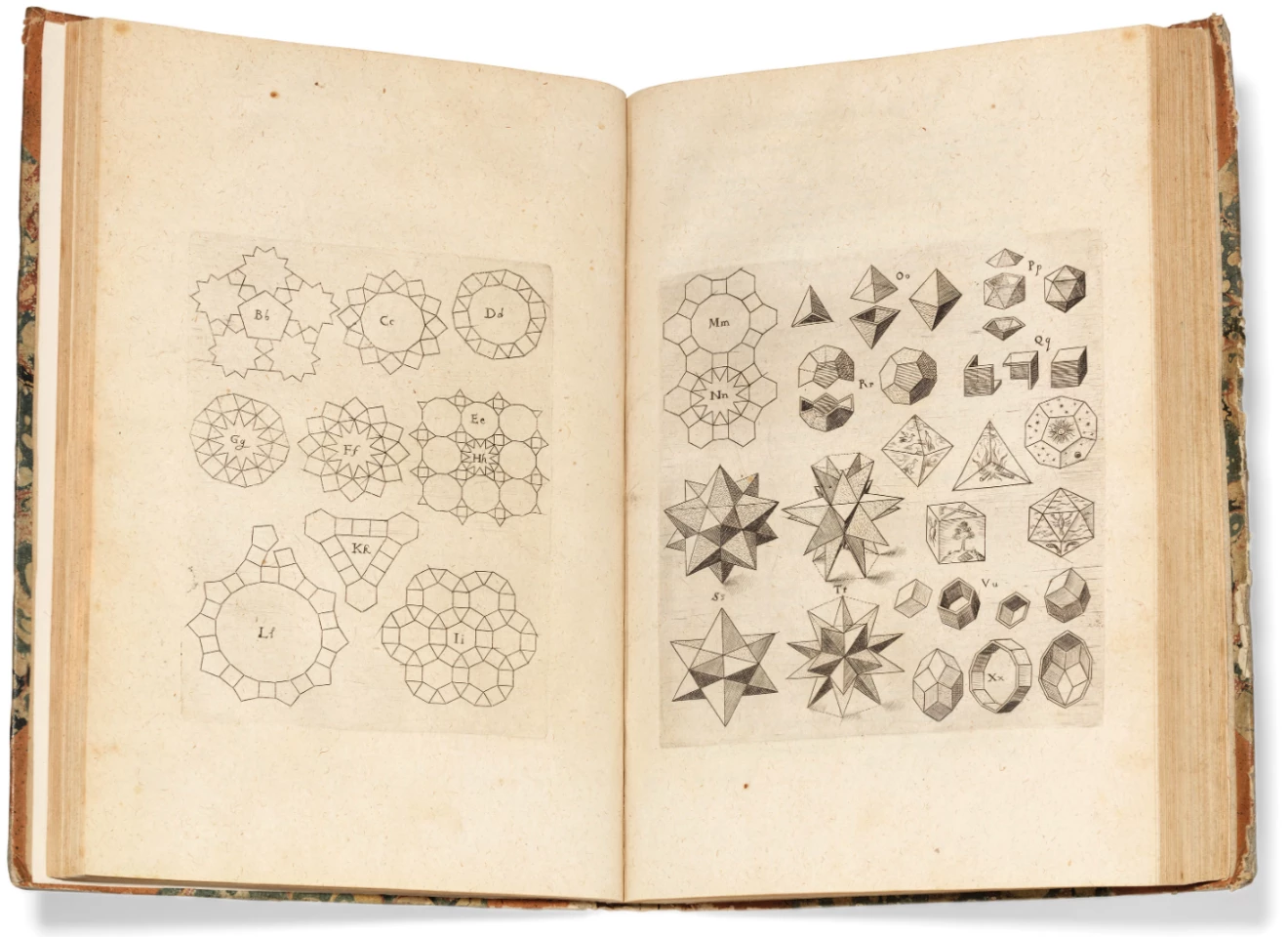
Auction Description | Estimate: $88,620 to $126,600 | Auction Date: July 9, 2019
Johannes Kepler (1571 – 1630) was a German astronomer, mathematician, and astrologer. He is a key figure in the 17th-century scientific revolution, best known for his laws of planetary motion, and his books Astronomia nova, Harmonices Mundi, and Epitome Astronomiae Copernicanae. These works also provided one of the foundations for Newton's theory of universal gravitation.
The book at auction is a first edition of Kepler's great cosmological treatise, containing the third law of planetary motion.
Horologium oscillatorium sive de motu pendulorum ad horologia aptato demonstrationes geometricae by Christiaan Huygens (1673)
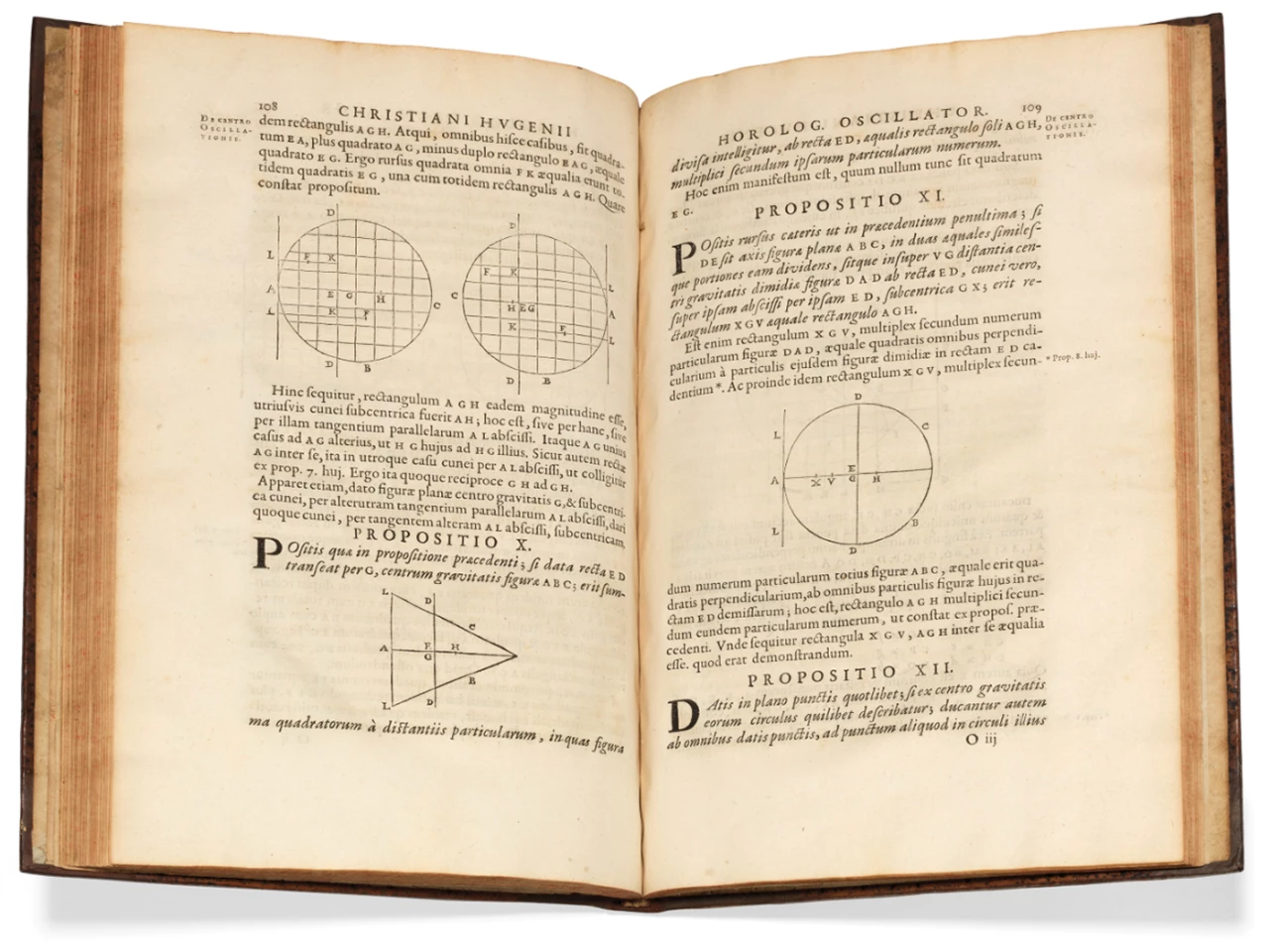
Auction Description | Estimate: $15,192 to $20,256 | Auction Date: July 9, 2019
Christiaan Huygens (1629 – 1695) was a Dutch physicist, mathematician, astronomer and inventor, who is widely regarded as one of the greatest scientists of all time and a major figure in the scientific revolution. In physics, Huygens made groundbreaking contributions in optics and mechanics, while as an astronomer, he is chiefly known for his studies of the rings of Saturn and the discovery of its moon Titan. As an inventor, he improved the design of the telescope with the invention of the Huygenian eyepiece. His most famous invention, however, was the invention of the pendulum clock in 1656, which was a breakthrough in timekeeping and became the most accurate timekeeper for almost 300 years. Because he was the first to use mathematical formulae to describe the laws of physics, Huygens has been called the first theoretical physicist and the founder of mathematical physics.
From Christie's auction description, the book on offer is "a presentation copy of the first edition of Huygen's most important work, containing the first mathematical analysis of the motion of the pendulum, and a general treatise on the dynamics of bodies in motion. The treatise 'was the most original work of this kind since Galileo's Discorsi.... It ends with 13 theorems (without proofs) on the dynamics of circular motion. Newton in the Principia acknowledges Huygens's priority here, though Huygens's work had little influence on his own' (PMM). 'A work of the highest genius which has influenced every science through its mastery of the principles of dynamics. It is second in scientific importance perhaps only to the Principia' (C. Singer, A Short History of Science …, 1941, p. 258)."
Historia naturalis by Gaius Plinius Secundus (written c.75, published 1497)
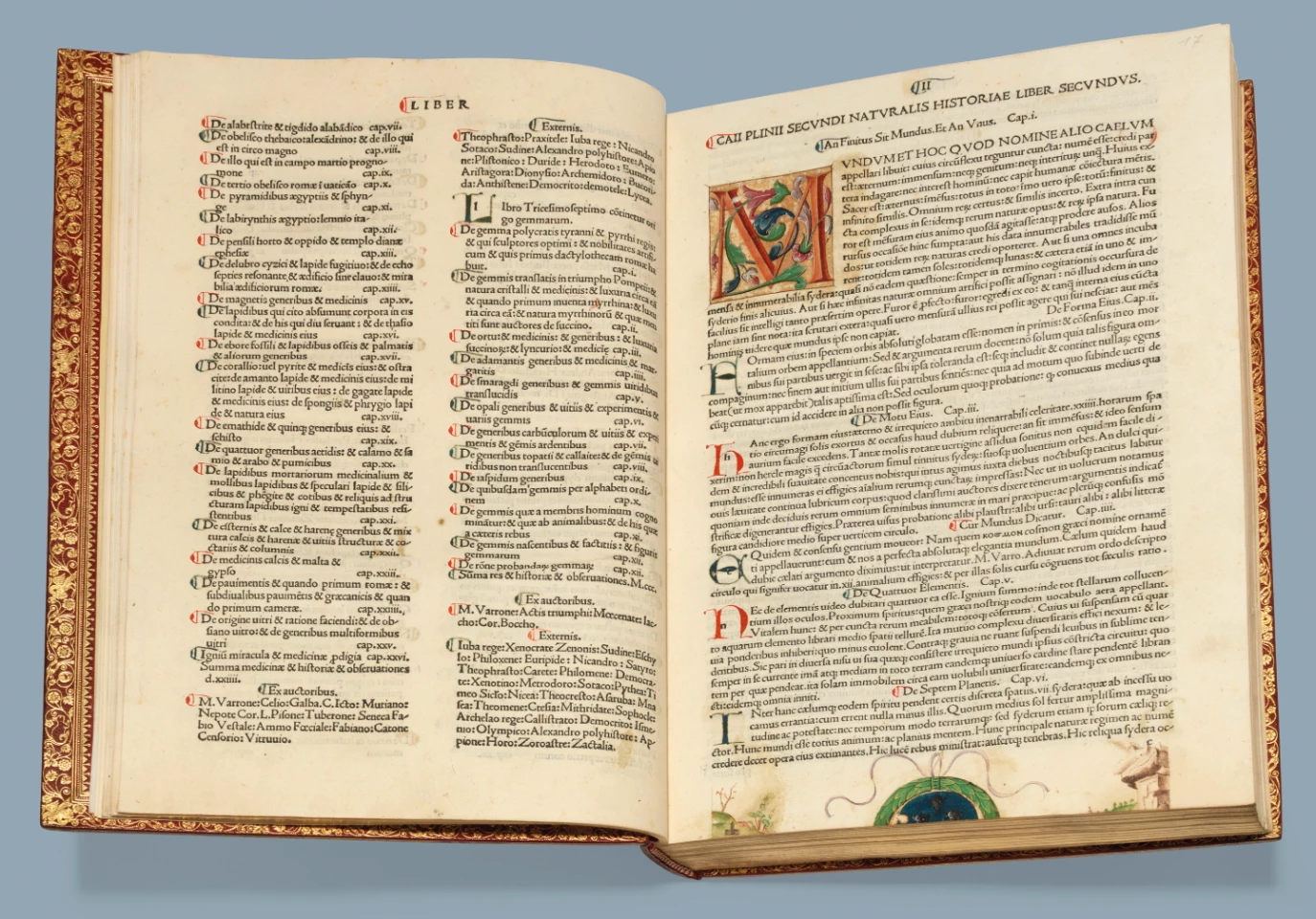
Auction Description | Estimate: $10,128 to $15,192 | Auction Date: July 9, 2019
Pliny the Elder (born Gaius Plinius Secundus, AD 23–79) was a Roman author, a naturalist and natural philosopher, a naval and army commander of the early Roman Empire, and a friend of emperor Vespasian.
Historia Naturalis is a breathtaking work in its size and breadth and the largest single work to have survived from the Roman period. It is even more remarkable in that it is the work of just one man: Gaius Plinius Secundus (AD 23 – August 25, AD 79), also known as Pliny the Elder.
This book is essentially the first encyclopedia, referencing 3,900 other work (with many more sources unattributed) and addressing a massive variety of subjects in attempting to chronicle every subject of knowledge known to man. Pliny must have been a remarkable man to even attempt such a monumental work, let alone achieve it.
The record price for this work is $1,073,863 (£601,600), fetched at a Sotheby's (London) auction in October, 2005.
From Sotheby's extensive auction description: "Born near Como into the wealthy equestrian class in 23 or 24 AD, he held various public posts and his service to the Roman Empire and his experience at various levels and in different parts of the empire, including Spain, served him well in his writing. He was enormously industrious, read constantly and made notes. When travelling in a litter he had a slave read to him, and grasping at interesting 'gobbets' dictated these to another to note. He had teams of people doing this, and it was these notes, for which a rich man was at one time to offer an enormous sum, which form the material of his greatest work. The public and administrative aspects of his life would have enabled him to "have seen how knowledge of the periphery was gathered, how it was used locally, in what shape it was sent to the centre of power, and the uses to which it was put when it arrived there. His encyclopaedia reflects this experience: for the 'Natural History', Roman power is what has united the world and opened it up to be looked at... This triumphalism is fundamental to the 'Natural History'. Everything that was to be known about the world was only available in the first place to be collated, and transmitted in an encyclopaedia because of Roman power..." (Murphy, op. cit. p. 5).
Encyclopédie, ou Dictionnaire raisonné des sciences, des arts et des métiers by Denis Diderot & Jean D'Alembert (1751-1780)
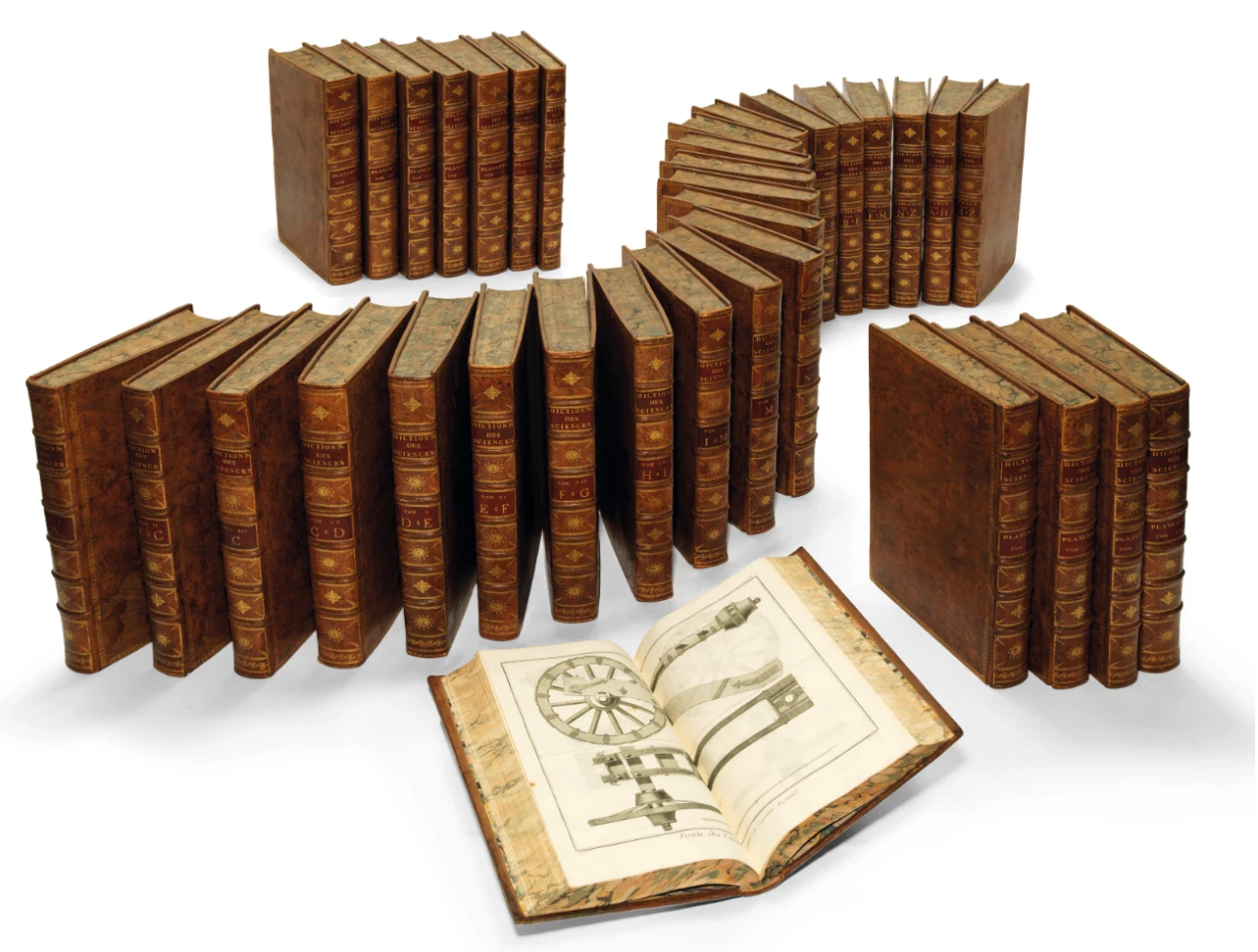
Auction Description | Estimate: $31,650 to $44,310 | Auction Date: July 9, 2019
From the auction description, this is a first edition of "one of the most splendid products of the Enlightenment, and one of the great landmarks of western intellectual history in a contemporary binding. 'A monument in the history of European thought; the acme of the age of reason; a prime motive force in undermining the Ancien régime and in heralding the French Revolution; a permanent source for all aspects of eighteenth-century civilization' (PMM). 'The greatest encyclopedia of science, which had widespread effect in establishing uniformity of terminology, concept, and procedure in all fields of science and technology' (Grolier/Horblit). The majority of entries were written by Diderot and D'Alembert; other collaborators included Baron d'Holbach, Rousseau, Voltaire, Montesquieu, Buffon, Marmontel, Condorcet, Necker and Turgot. The first seven volumes of the Encyclopédie were published in Paris under a royal privilege; when this was withdrawn in 1759 printing continued clandestinely, and the last ten volumes were issued under the false imprint of Samuel Faulche, Neuchâtel."
Thèses présentées a la Faculté des Sciences de Paris pour obtenir le grade de docteur ès sciences physiques by Marie Curie (1903)

Auction Description | Estimate: $10,128 to $15,192 | Auction Date: July 9, 2019
Marie Curie (born Maria Salomea Skłodowska; 1867 – 1934) was a Polish and naturalized-French physicist and chemist who conducted pioneering research on radioactivity. She was the first woman to win a Nobel Prize, the first person and only woman to win the Nobel prize twice, and the only person to win the Nobel Prize in two different scientific fields. She was part of the Curie family legacy of five Nobel Prizes. She was also the first woman to become a professor at the University of Paris, and in 1995 became the first woman to be entombed on her own merits in the Panthéon in Paris.
The copy to be auctioned is a first edition of Marie Curie's most significant publication.
Historique et description des procédés du daguerrotype et du diorama by Louis Daguerre (1839)
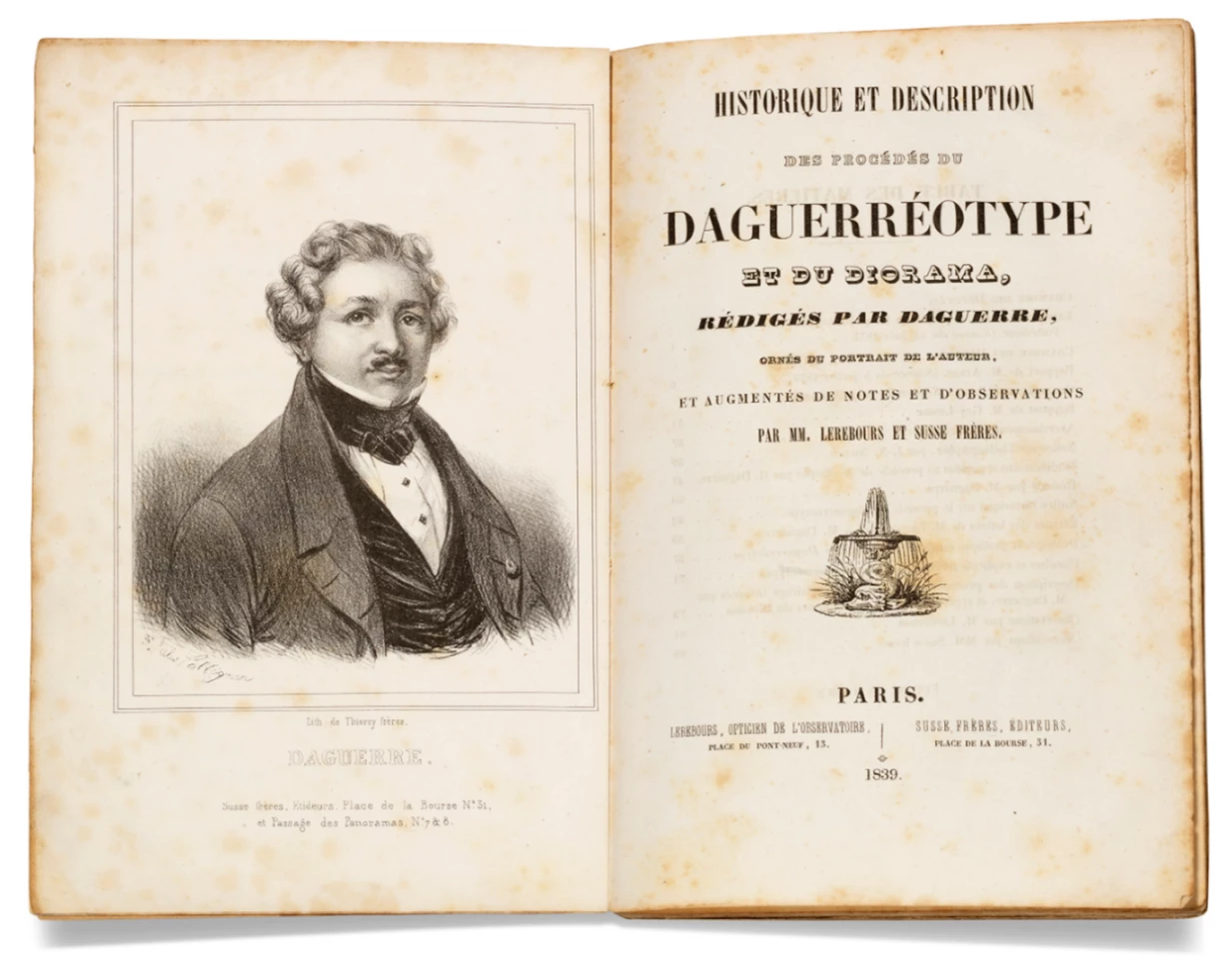
Auction Description | Estimate: $3,798 to $6,330 | Auction Date: July 9, 2019
Louis-Jacques-Mandé Daguerre (1787 – 1851) was a French artist and photographer, recognized for his invention of the daguerreotype process of photography. He became known as one of the fathers of photography. Though he is most famous for his contributions to photography, he was also an accomplished painter and a developer of the diorama theatre.
The copy to be auctioned is a first edition, 7th issue, of Daguerre's exposition of his photographic process.
From the auction description: "News of the development was electric: 'perhaps no other invention ever captured the imagination of the public to such a degree and conquered the world with such lightening rapidity as the daguerreotype' (Gernsheim, p. 71). Along with the official documents relating to the government's review of the procedure, Daguerre's manual includes details of its genesis, a transcription of Niépce 's own description of his heliographic process, and a full illustrated description of the daguerreotype process. The work, published by order of the government, was quickly sold out. A total of 39 reprints, new editions, and translations appeared in the following 18 months. The great demand accounts for the profusion of issues of the first edition: seven are recorded, all from the same basic setting of type, differing only in the title-page and advertising leaves. ... All issues of the first edition are rare."
Die galvanische Kette, mathematisch bearbeitet by Georg Ohm (1827)

Auction Description | Estimate: $6,330 to $10,128 | Auction Date: July 9, 2019
Georg Simon Ohm (1789 – 1854) was a German physicist and mathematician. As a school teacher, Ohm began his research with the new electrochemical cell, invented by Italian scientist Alessandro Volta. Using equipment of his own creation, Ohm found that there is a direct proportionality between the potential difference (voltage) applied across a conductor and the resultant electric current. This relationship is known as Ohm's law.
The auction copy is a first edition of a pioneering work in the development of electrical science, containing the first fully developed presentation of Ohm's theory of electricity.
Zur Theorie des Gesetzes der Energieverteilung im Normalspectrum by Max Planck (1900)
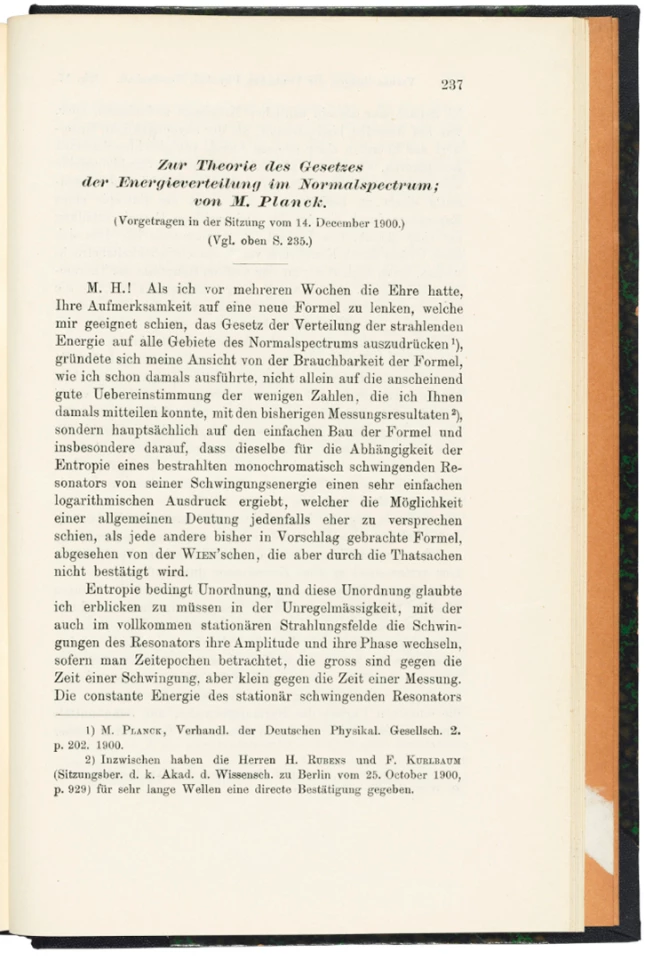
Auction Description | Estimate: $8,862 to $12,660 | Auction Date: July 9, 2019
Karl Ernst Ludwig Marx (Max) Planck (1858 – 1947) was a German theoretical physicist whose discovery of energy quanta won him the Nobel Prize in Physics in 1918. Planck made many contributions to theoretical physics, but his fame as a physicist rests primarily on his role as the originator of quantum theory, which revolutionized human understanding of atomic and subatomic processes.
From the auction description, the auctioned copy is "the first appearance of Planck's quantum theory. 'In this important paper he stated that energy flowed not in continuous, indefinitely divisible currents, but in pulses or bursts of action [or quanta]' (Dibner). Planck determined a unit of energy in a system showing a natural frequency in definite quanta and proposed a constant of angular momentum, the value of which is known as "Planck's constant." This unit of energy enabled the explanation of wave-length, specific heat of solids, photo-chemical effects of light, the orbits of electrons in the atom, the wave lengths of the lines of the spectrum, or Röntgen rays, the velocity of rotating gas molecules, and the distances between the particles of a crystal. 'It contradicted the mechanics of Newton and the electromagnetics of Faraday and Maxwell. Moreover it challenged the notion of the continuity of nature' (PMM)."
Molecular Structure of Nucleic Acids by James Watson and Francis Crick (April 25, 1953)
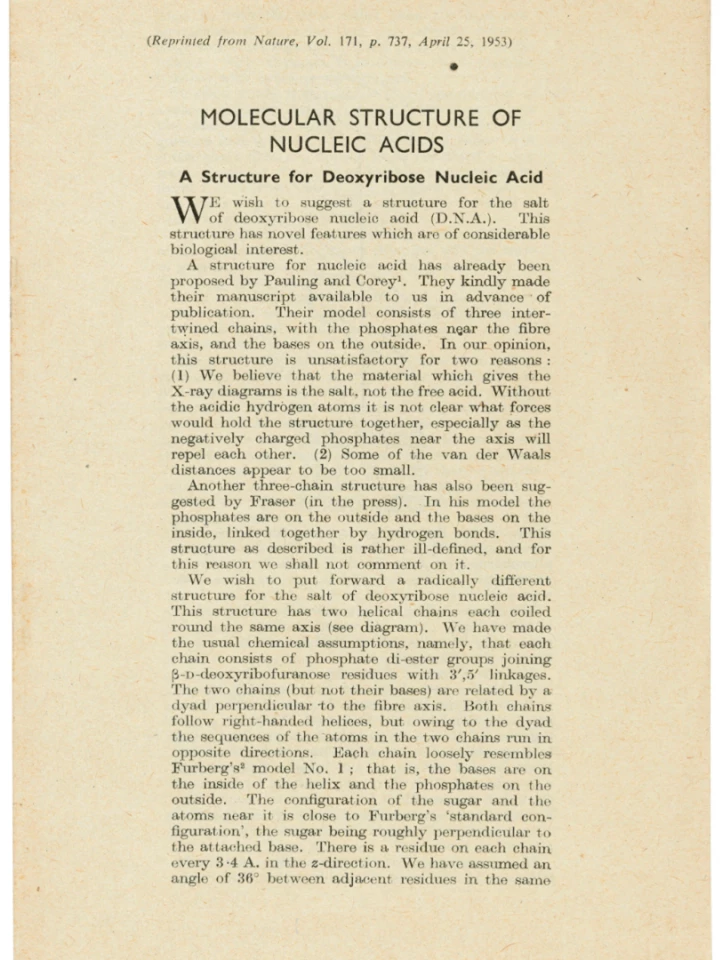
Auction Description | Estimate: $7,596 to $10,128 | Auction Date: July 9, 2019
Francis Crick (1916-2004) was a British physicist who at 31 years of age moved his academic field of endeavor to the study of biology. Six years later, he would make one of the landmark scientific breakthroughs. With Crick working alongside James Watson, and building upon the work of Maurice Wilkins, Rosalind Franklin, Alec R. Stokes and others, the pair finally decoded the structure of deoxyribonucleic acid (DNA) on Saturday, 28 February, 1953.
The discoveries of Crick and Watson, which led to our understanding of DNA, are in the same category as the landmark scientific discoveries of Copernicus, Kepler, Galileo, Einstein and Newton.
In April, 2013, a letter from Crick to his son revealing the discovery of the structure of DNA sold at a Christie's (New York) auction for $6,059,750, making it one of the 50 most valuable scientific documents and manuscripts of all-time. That same month, a Nobel Prize medal won by Francis Crick for the discovery of the structure of DNA sold for $2,270,500 – 50 times more than any prior Nobel Prize medal. The high price immediately catalyzed a new marketplace for Nobel Price medals, with prices exceeding $500,000 now the norm. The price set by Crick's Nobel Prize was more than doubled 20 months later when Christie's sold James Watson's medal for $4,757,000 in December, 2014.
The lot on offer at Christie's is Watson and Crick's original paper and copies of this paper have previously sold for astonishing amounts too. Last month (June, 2019), Christie's sold the galley proofs for this paper, signed by Crick and Watson, for $350,000. In 2008, Christie's sold a copy signed by Crick, Watson, Wilkins and Stokes for $86,500, and previous copies of this paper signed by both Crick and Watson have sold for $62,500 and $42,000, so although this paper isn't signed, it does represent a landmark in scientific history.
De viribus electricitatis in motu musculari commentarius by Luigi Galvani (1791)

Auction Description | Estimate: $6,330 to $10,128 | Auction Date: July 9, 2019
Luigi Galvani (1737 – 1798) was an Italian physician, physicist, biologist and philosopher, who discovered animal electricity. He is recognized as the pioneer of bioelectromagnetics. In 1780, he discovered that the muscles of dead frogs' legs twitched when struck by an electrical spark. This was one of the first forays into the study of bioelectricity, a field that still studies the electrical patterns and signals from tissues such as the nerves and muscles.Galvani's wife Lucia Galeazzi Galvani was also an Italian scientist who worked with her husband in his experiments, and in his work as a surgeon and obstetrician. Due to the conventions of the time, she wasn't credited for any scientific work she may have done in the laboratory, but she undoubtedly contributed greatly to the contents of this book. She grew up with science and her father was a prominent member of the Bologna Academy of Science.
The copy to be auctioned is a rare first edition, first issue of this momentous paper "showing that electric currents could produce measurable biologic phenomena ... a foundation for the study of electrophysiology" (Grolier/Norman).
Theatrum orbis terrarum by Abraham Ortelius (1595)
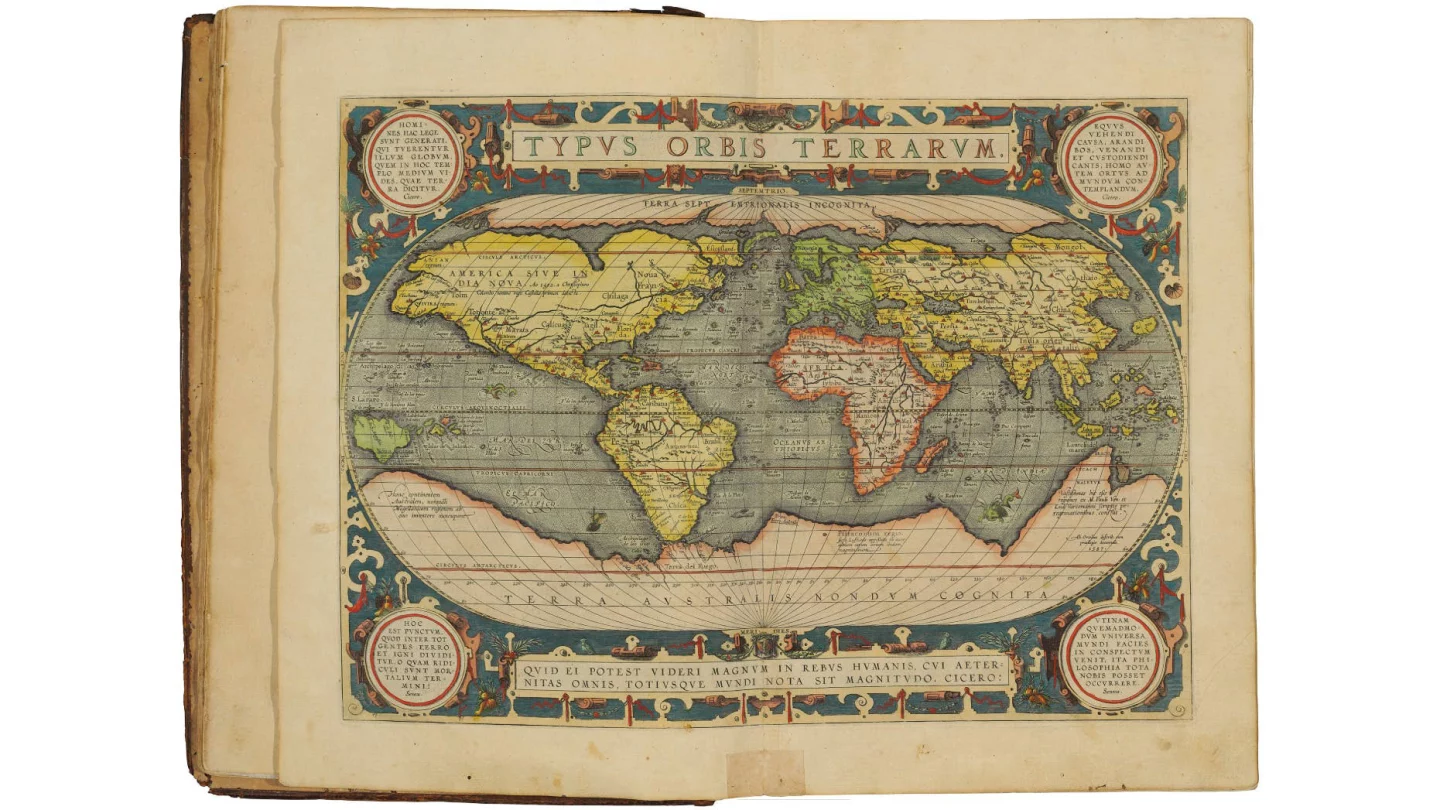
Auction Description | Estimate: 63,300 - USD 101,280 | Auction Date: July 10, 2019
Abraham Ortelius (1527 – 1598) was the Brabantian cartographer who created the first modern atlas, the Theatrum Orbis Terrarum (Theatre of the World) and shaped the future of cartography. Ortelius' Theatrum consists of two distinct elements, text and maps, and this format had not been done previously. Ortelius was also one of the major factors in moving the map trade from Antwerp to Amsterdam, and he is also believed to be the first person to imagine that the continents of the world were joined prior to drifting to their present positions.
The record price fetched for a copy of this book was set in July 2000, when an illuminated copy bound as a gift from Cosimo II de' Medici fetched $419,240. The copy was bound in Italian burgundy morocco gilt, though the recipient of the gift remains unknown. Cosimo II was one of Galileo's students, and subsequently a patron, and Galileo named Jupiter's four largest moons Medicean Stars in reference to Cosimo and his three brothers.
Recent sales of this landmark publication have fetched $253,217 (£193,750) at a Sotheby's auction in November, 2017, $129,197 (£100,000) at a Sotheby's auction in May, 2019, $118,666 (£93,750) at a Christie's auction in December, 2018, and $75,000 at a Christie's auction in June, 2013. | Full copy available on the internet
The copy of the Theatrum to be auctioned is a coloured copy in a contemporary binding.
Autograph manuscript, diagrams and notes relating to quantum physics by Niels Bohr (1933)

Auction Description | Estimate: $7,596 to $11,394 | Auction Date: July 10, 2019
Niels Bohr (1885 – 1962) was a Danish physicist who made foundational contributions to understanding atomic structure and quantum theory, for which he received the Nobel Prize in Physics in 1922. Bohr developed the Bohr model of the atom, in which he proposed that energy levels of electrons are discrete and that the electrons revolve in stable orbits around the atomic nucleus but can jump from one energy level (or orbit) to another. Although the Bohr model has been supplanted by other models, its underlying principles remain valid.
The lot to be auctioned is a four-page autograph manuscript, with diagrams and notes relating to quantum physics, made in discussions between Bohr and Ernest Lawrence (who would win the Nobel Prize for Physics in 1939) on the train between Berkeley and Omaha in June, 1933. Both would subsequently work on the Manhattan Project.















